Col. Sudhir Farm
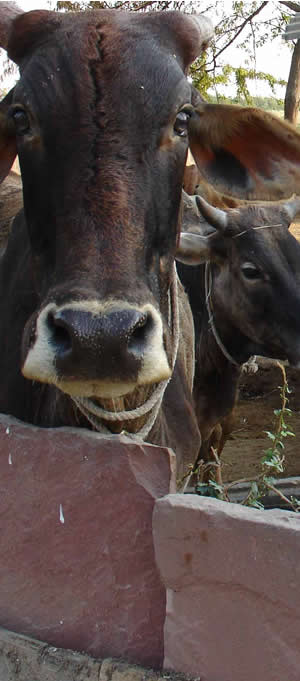
Snippets from the Visitors' Book
I loved staying with you and the dogs and playing with the toys.
Jonas aged 8, Switzerland
A very welcome break from the crazy world of India – wonderful house, food and hospitality. Thank you so much.
Katie Buxton, Bath, UK
I loved seeing the crocodiles, and I learned a lot about deticking the puppies. Coming to the farm was a great experience.
Stella Bartholet, Washington, USA

On the Farm
Peaceful and Quiet
By the time you leave us we expect you will be rejuvenated. There is much to keep one occupied on the farm, when not exploring beyond. Birdwatching is one of them (See Birdlife).
Relax - Read
If reading is one of your pastimes, we have a well-stocked library for all ages to choose from. You can relax in the garden or on one of the verandahs and while away the hours as you soak-up the sun. We have even arranged yoga classes on the farm for our guests.
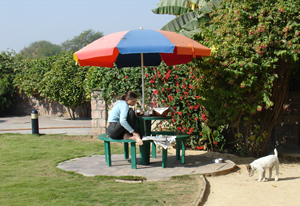

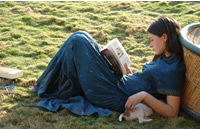
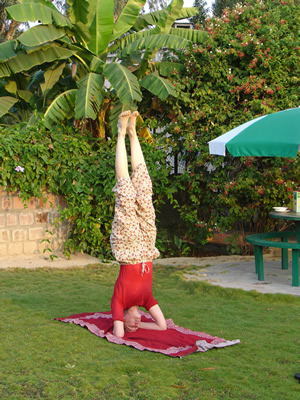
Local Farming
Why not learn about the local farming methods and local social customs as you watch the cows being hand milked.
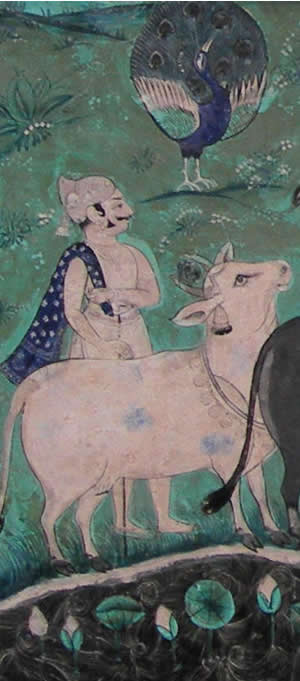
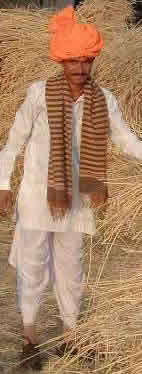
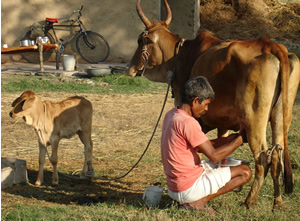
Farm News
On the Farm - September ’25
An unusual monsoon month as whereas large swathes of northern India were underwater we only had 1.81 cms. of rain all month and it rained or drizzled on just four days. The result was that it was very humid and with the electricity going on and off, all day and night, we were dependent on our two inverters and four batteries for back up.

The fields dried out and so ploughing could begin to prepare for mustard. The rice needed constant watering and the main activity was weeding the rice. A team of eleven came most days and here they are back in their respectable clothes for walking home. Kamla Bai cuts and carries head loads of cut weeds and grass for her cows. As they walk back, along the irrigation minor, which looks as if it has been here forever rather than only since May, a couple of women search for a particular plant needed for the evening puja they are about to arrange when they get home.

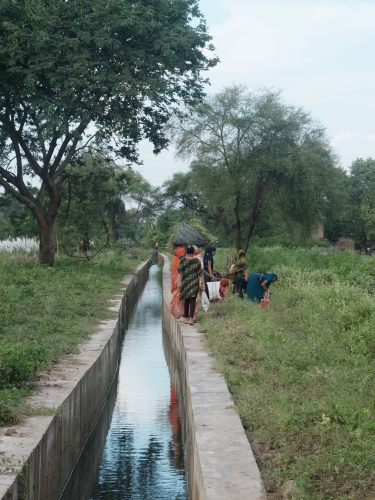
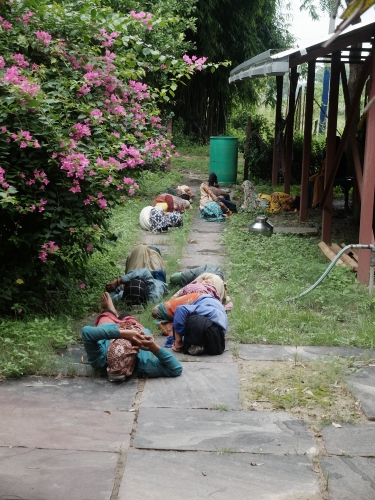
The women come prepared to work through rain. They start at 10.00am and take 1.00pm to 2.00pm off when they eat the lunch they have brought and look for a dry patch on which to sleep and rest. They finish at 5.30pm and head back home. The going rate is Rs.300 a day.

The tragedy in September was that the young calf, Kumbh, was found dead near the transformer by the boring in the south end of the farm. We will never know if he was electrocuted or bitten by a wild animal as he was carried away by the retired cobbler on his bicycle for Rs.500.
A September success was getting rid of the old very heavy washing machine, which had been waiting nearly a year on the flat roof for a kabari wallah to come with a van. We also sold the old Avery scales which couldn’t be mended. Total income Rs.2980 from the kabari wallah - nearly GBP 30 and no costly trip to a tip needed.


A September milestone was an early 75th birthday lunch for Vijay and his sisters. His sister Sadhana has been with us for several weeks and his youngest sister, Sarandha, came from Jaipur. We hope that Sadhana will be walking freely again soon after a hairline fracture to her left knee from a fall.

An unexpected September visitor was a 3-foot crocodile spotted on the drive near the irrigation minor but not seen since. You can never be too careful around here!

On the Farm - August ’25
August in retrospect was a wet month but in fact it hardly rained for the first two weeks. We had 32.92 cms. on 16 different days which was less than the 38.31 cms. of July. The most was 9.5 cms. overnight on the 22nd which was the heaviest by far.
Here you can see Narayan outside his house and significant flooding. Our new irrigation minor turned out to be a major problem during downpours. It became a drain for rain water from land upstream and there was no control over this water from rushing onto our farm and our neighbours farm. It needed a means to relieve and control this unwanted flow. So we made an opening for the rain water to empty into the drain along the other side of the road and stopped further flow on our farm with sand bags. Attempts to involve the irrigation department in allowing such an outlet when the minor was being constructed were unsuccessful as this problem had been forseen.
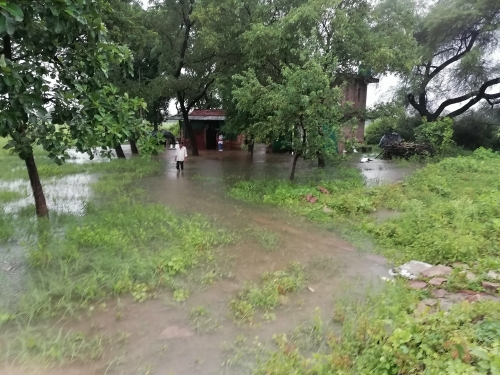
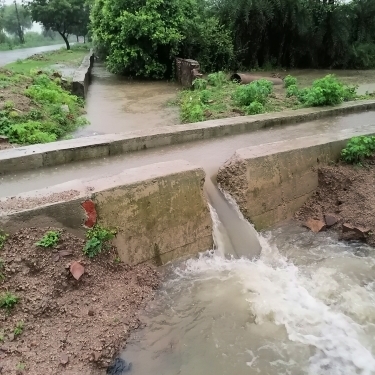
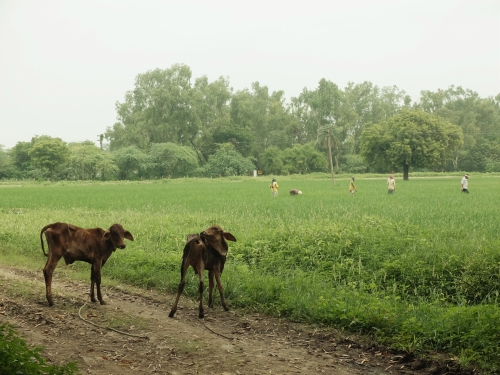
Meanwhile the rice weeders were coming most days starting on the 11th. You can see our two youngest calves, Ganga and Kumbh, having the run of the farm during the day. Kumbh was born during the Kumbh Mela in February.

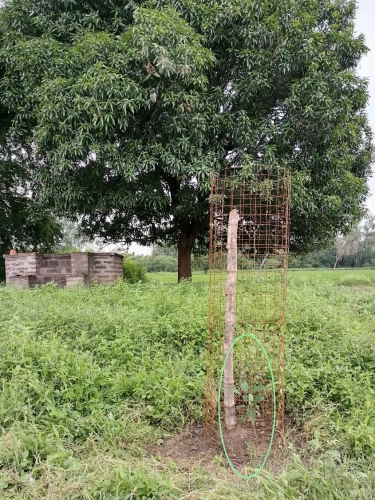
The monsoon is the best time of year for tree planting but each tree must have a tall guard. Our daughter Anjali was asked to bring a deshi, and ideally wild, mango tree from Mandu in Madhya Pradesh on the Vindhya Range, which is famous for its wild mango forests. She brought one back on the train and it was planted on the mound near the well where the splendid gulmohar used to flower bright red and orange, and which had tragically fallen prey to termite infestation. We call it our Mandu Mango.

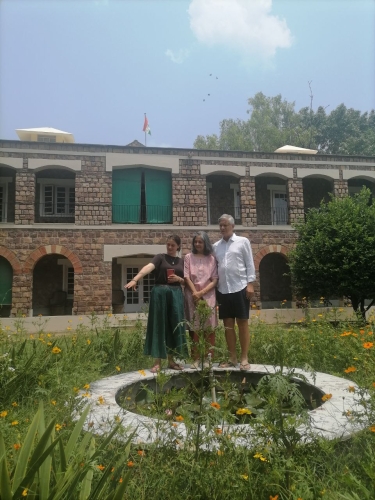
August 15th is Republic Day and we fly the Indian flag up on the roof flagpole. Vijay’s sister was staying with us and Anjali was with us at that point. A sunny, breezy and very pleasant day.


As the rice fields filled up with water the rice weeders began to complain about leeches and asked us to buy them socks. They bought the long white socks, we reimbursed them, and they stopped complaining and so they must have worked. They took them off to dry during their lunch break and put them back on wet for the afternoon session.
The other complaints were coming on behalf of the cows who couldn’t sleep because of the humidity and the mosquitoes, so two fans were fixed up for them and they sat happily under the circulating air, whenever the power was on, chewing their cud.

On the Farm - July ’25
A wet July from beginning to end. We had 38.31 cms. of rain on 20 separate days and were able to transplant rice in good time. The themes of the month were rice transplanting and tree planting and incorporating the new irrigation minor into the agricultural cycle of the farm. Eleven women came to transplant rice on 9th July and they worked their way around the farm come rain or shine.
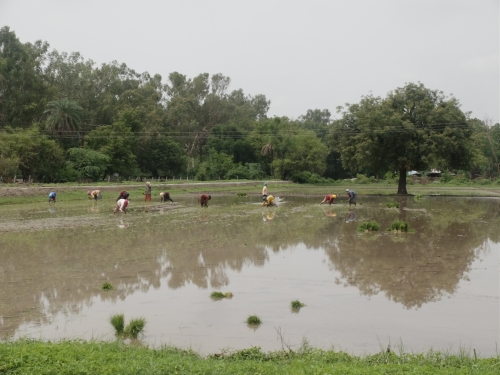

Here the women can be seen transplanting in sunshine and planting in heavy rain protected by a thin sheet of plastic. They were cold in the rain and asked for tea to help them warm-up, but we did not have any milk and brewed up a sweet tulsi tea and encouraged them to dance under the grain port where they were having their lunch.

Ghansi was planting rice on the next farm but their transformer had burnt out and could not water his rice. However, he was able to pump water from our borewell into the new irrigation minor at one end of our farm and deliver to his fields at the other end in the neighbouring farm. You can see that the barren look of May has already been transformed by the rain and we planted local trees along the minor, protecting each one with a wire mesh guard to deter nilgai, cows and monkeys.

By mid-July the seasonal wild green plants, much loved locally, were ready to be picked and enjoyed.
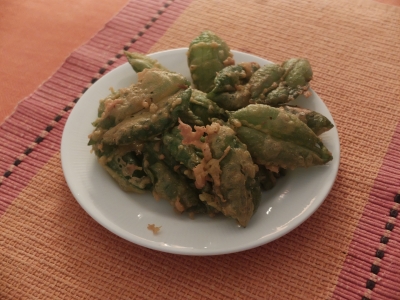
These crispy pakoras were made from the leaves of bhokna.
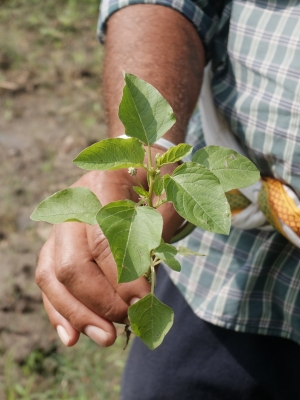
Khunijado as shown here makes a tasty subjee.

This small leafed plant is called poadia and also makes a seasonal subjee after boiling, squeezing and frying in oil and spices.

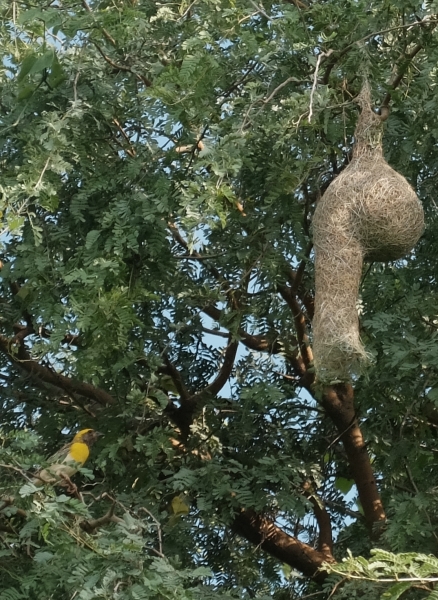
The baya weaver birds (Ploceus philippinus) appeared and started building their extraordinary nests. Each evening we would walk past and see the progress. This photograph shows a male besides a finished nest.


Towards the end of July our daughter, Anjali, visited from England and we went for a monsoon picnic to Bisalpur Dam. The dam was finished in 1999 and now provides most of the drinking water for Jaipur, Ajmer and Tonk districts. It is located amongst hills 2.5 hrs./130 kms. NNW of here on the Banas River and we had never visited it before. The signs to the dam say ‘No Entry’ but we went anyway and found a welcoming security guard who waved us on. When asked why the initial sign said ‘No Entry’ he gave a peculiarly Indian rationale. "We first tell them no entry and let them visit the dam so they are more ‘alert’!"
There were many temples in the vicinity and many pilgrims walking towards these temples. Pilgrims buy food such as roasted sweetcorn and bananas. The food attracts troops of macaques..
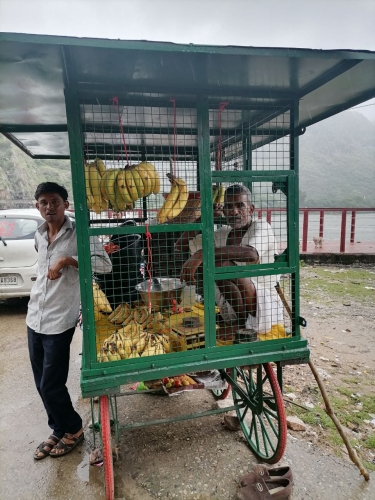
My final July photo is of the banana seller crouching in his cage with his bananas while the monkeys have the run of the dam area!

On the Farm - June ’25
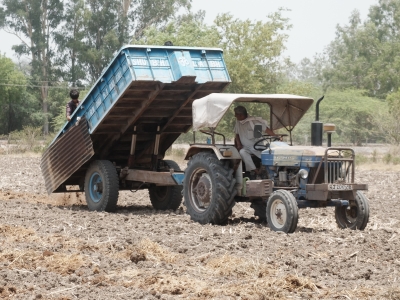
June was a very unusual month and had two distinct halves. We were expecting heavy rain from the 15th and had to finish the usual June tasks before that. The gobar manure from the cows is stored in a pit and we employed six young tribals to fill the tractor-trolley and shovel it out of the tipping trolley into the chosen field this year.

This young group of tribal folk, who spread the gobar, move to Kota from their village in Madhya Pradesh after monsoon has past and work as casual labour as a group while living in a temporary structure made waterproof by a black plastic sheet. As soon as the heavy rain starts they return to their village to plant and tend their one monsoon crop.


Another job that needed doing was to deal with the knocked down trees and brushwood pushed to one side during the construction of the irrigation minor which has no access to water (see last month’s blog). Vijay used his chainsaw to limb and buck the trees ready for the saw mill in Kaithoon to collect them. It was tiring work and he did two hours on alternate days (the non-swimming ones).
On the 15th the tractor-trolley arrived to collect our sawed tree trunks and branches. Weighbridge showed we were selling 4100 kgs. @ Rs.2/kg. We had more to be sold when cut, but the rains arrived on the 16th and the saw mill owner’s workers all left for their villages to plant their crops and would not return in a month or more.
During this period our cow man had a phone call to say that his sister’s son had fallen from a roof where he was doing reinforced concrete work and an iron bar had gone through his leg. Narayan left immediately for Madhya Pradesh to help deal with such a tragic accident. We are assured that he is now ‘fine’.

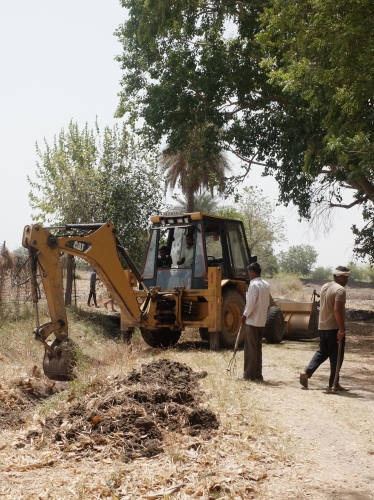
We hired a Caterpillar excavator (CAT) and driver to move wood around and dig some drainage trenches and excavate some existing ones. Shrawan Suman charged Rs.1100 an hour and arrived early in the morning with an assistant and worked until 7.00 pm with diesel cost payable in advance. He worked for four days with temperatures going over 40oC.


The first pre-monsoon shower arrived on 16th June and we had over 2 cms. of rain. On the 21st we had 10 cms. within 24 hours and all the fields became flooded. Our Honda Brio got stuck in the mud and it is back to being parked in the open but on flagstones. All in all we had 24.18 cms. of rain in June on 13 different days. The farm was transformed from a dry baked spot to a lush green parkland. Here is a photo of our rain gauge and equipment at dawn. You can see that the fields behind are flooded.

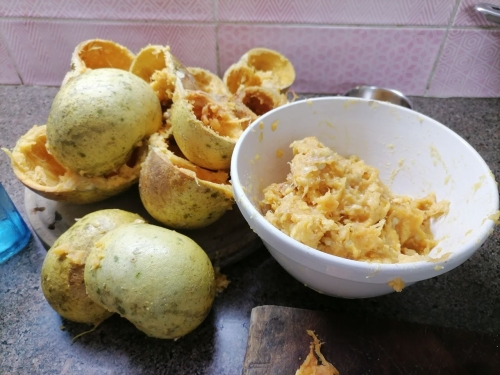
Our thoughts turn to tree planting and Laxman is growing Bael/Beel (Aegle marmelos) from seed. We were given some rather old Bael fruit and took out the seeds and germinated them hoping to have a line along the Death and Destruction irrigation minor. Bael Patra is often found near temples as it is considered to be a sacred tree for Hindus. Goddess Lakshmi lives in the leaves and Lord Shiva lives under it. The tree is said to remove negative energy and fill the environment with positivity. The flesh of the fruit can be made into a nourishing health giving drink and so we are looking forward to our own supply some day!

For green manure we broadcast sunnhemp in some of the fields but they were too wet to plough. However, by 30th June we had been able to plough most of the fields.

On the Farm - May ’25
Death and Destruction (See April’25) continued for most of May and farm life went on alongside. It was an unusually showery month and we had rain on six separate days with a total of 2.22cms. Heavy rain forecast for 11th May led us to delay selling the wheat.
In April there were daily tractor jams at the grain market and we waited for that to clear. The wheat was kept under black plastic tirpals or tarpaulines. Some rain did seep in from underneath and a little grain was spoiled to be sold separately for a cheaper rate.
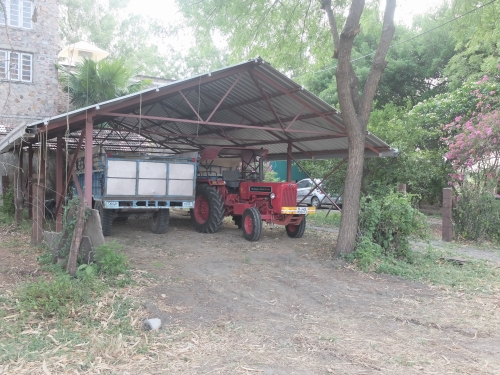
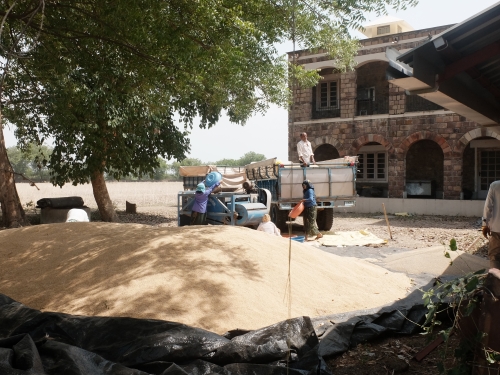
On 13th May, after the rain we filled two trolley loads and were able to park both of them in our car-port/grain-port. On the 14th both trollies left for the mandi at 7.00am and the wheat sold for Rs.2501/100kgs. or quintal. Wheat from some fields had been plagued with the weed Pholaris minor know locally as gulli danda (See March’25 and April’25 blogs). This wheat was put through a sieving machine before loading in the trollies.
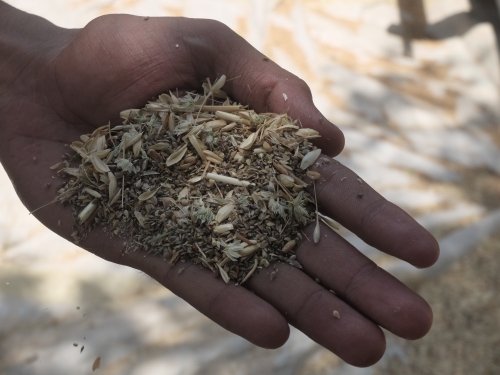
Here are the weed’s black-brown seeds which were removed. We did not want our cows to eat them and spread the seeds far and wide across the farm in their gobar and so they were put on a plastic sheet and wrapped and taken in a small trolley and dumped some distance away in the wild along the irrigation minor.

Which brings me to death and destruction. Another separate theme occurred in May as India reacted to Pakistan’s brazen killing of 26 Hindu tourists in Kashmir by attacking Pakistan’s terror camps and some military bases on the night of 7th May. Pakistan responded with Chinese made missiles and Turkish drones. This had the advantage for the makers of seeing how their equipment stood up in a war like scenario without their countries being involved. By 10th May, Pakistan had begged for a cease fire which we are currently in the midst of, but the world now knows that India can, and will, respond effectively.


The irrigation minor concreting had its own rhythm and went on from dawn to dusk daily until 20th May. Here you can see the shuttering, the completed section covered with jute sacks, and the water tanker which wet the sacks and concrete twice a day for 5 days.
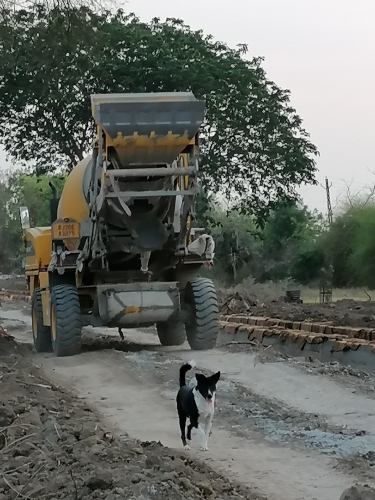 The dogs adjusted to the new realities and found their own roles to play. Here a very jaunty Doosra sets the pace for a reversing cement mixer.
The dogs adjusted to the new realities and found their own roles to play. Here a very jaunty Doosra sets the pace for a reversing cement mixer.
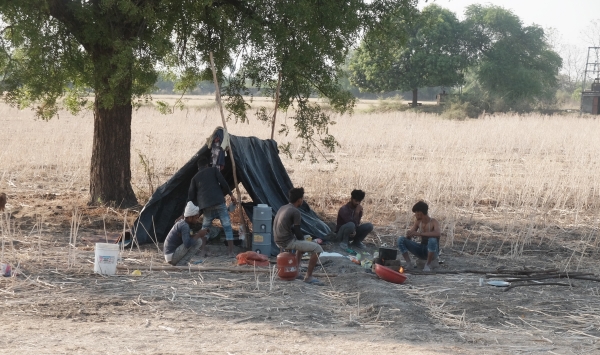
The Ferozabad boys moved their plastic tent home to under the neem tree and took it in turns to cook a proper meal each evening of chappatis, dal and a vegetable curry - usually potatoes. We gave them tomatoes while our splendid crop continued, and goat meat on one day to cheer them on.
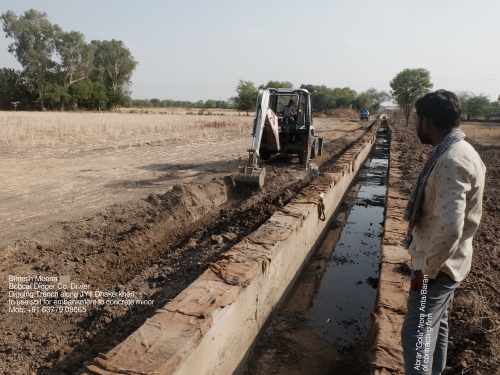
Once the concreting was finished a Bobcat digger arrived to dig a drainage channel alongside the minor and used the dug up soil to make an embankment along the concrete wall of the minor.
 Our farm drive was left in a narrowed and weakened condition but “there was no budget” to repair the havoc they had wrought. They did, however, erect shuttering and pour concrete to shore up the sides, and billed us Rs.12000.
Our farm drive was left in a narrowed and weakened condition but “there was no budget” to repair the havoc they had wrought. They did, however, erect shuttering and pour concrete to shore up the sides, and billed us Rs.12000.
When the team left, to all intents and purposes, the irrigation minor was complete, but someone had not consulted the National Highways Authority of India which had built an elevated by-pass over the course of the minor and now stopped the work claiming that they, the NHAI, owned the land underneath and on either side of the by-pass and intended to build a service road next to it. The NHAI removed the pipe that had transported water under the by-pass for years and now the farmers who had been receiving water through the Kanwarpura 2 Minor have had their water source removed by a government department which has no interest in their plight.
The result of so much death and destruction is that over 45 trees were bulldozed along our farm boundary to make a concrete irrigation minor which is cut off from the canal at its source of water. The NHAI has agreed to make the necessary joins itself but no date has been set. Meanwhile the trees will be trying to push their way back up through the concrete and alongside it. Which will happen first ?!

 And to end with a photograph of the cows grazing on the tomato plants as the vegetable garden is prepared for ploughing and the jackfruit on the tree in the front take over providing a source of nutrition which we share out weekly. Our variety of fruit trees and others keeps our pollinators fed all year round when it becomes too hot for the flowering crops.
And to end with a photograph of the cows grazing on the tomato plants as the vegetable garden is prepared for ploughing and the jackfruit on the tree in the front take over providing a source of nutrition which we share out weekly. Our variety of fruit trees and others keeps our pollinators fed all year round when it becomes too hot for the flowering crops.

On the Farm - April ’25

The theme for April was Death and Destruction, but before I get into that we had some good news.
On 1st April Ramini had a male calf and here she is with Ganga.

The deshi Bansi and C306 wheat for the house were handcut by our farmworkers and family members. The house wheat was threshed on the 11th and took less than an hour. On the 8th it was 40oC and the combine came and harvested 30 bighas of wheat in a few hours. There was no rain at all in April and so no loss from rain, hailstones or wind.
Six women started hand cutting 20 bighas of commercial wheat on 5th April. A male nilgai sat in the shade and watched the women work. When Sahib turned up it recognised his voice and thought it best to disappear. Vijay was able to capture this photograph of the women cutting wheat as Raja, as we call him, made himself scarce.

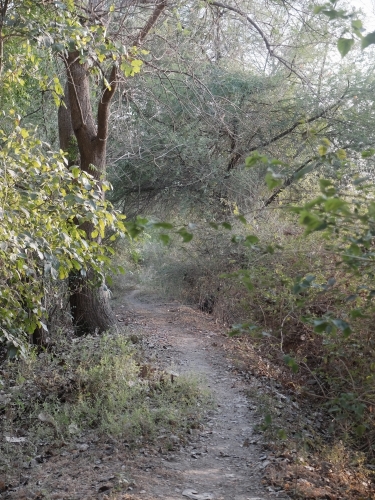
On 16th we had our last dog walk around the farm enjoying the re-wilded Butterfly Walk. Little did we know what was about to happen.
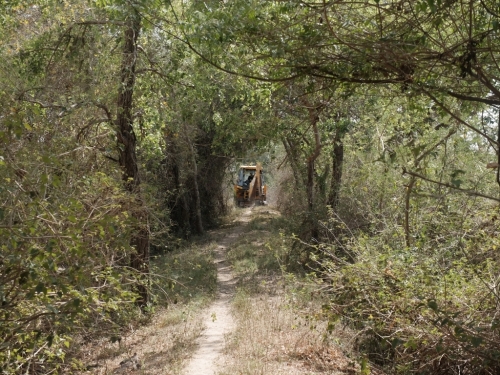
On 17th the JCB turned up and started Death and Destruction of our beloved Butterfly Walk.
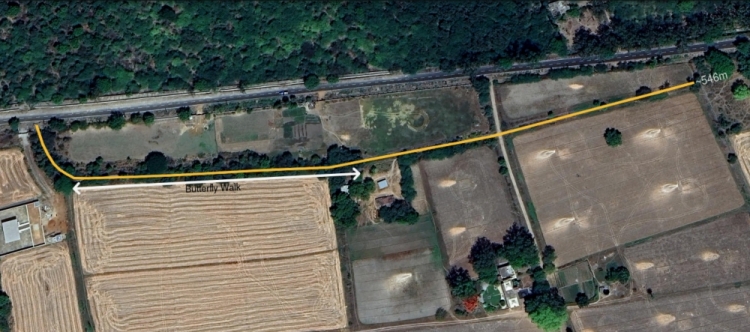
The irrigation minor from the canal (officially Kanwarpura 1 Minor 1.69 kms.) which has been defunct for over a decade is being repaired and upgraded in a systematic and efficient manner which necessitates the clearing of a broad strip of land and digging a 3.2m wide trench to take the concrete raft on which the embankments for the minor waterway are laid. Within a few days over 45+ trees had been smashed down and the undergrowth removed within our section of roughly 546m (yellow line). Groups of small birds flitted from bush to tree in large numbers issuing distress calls as their habitat was demolished by man and machine. It was really heart breaking.


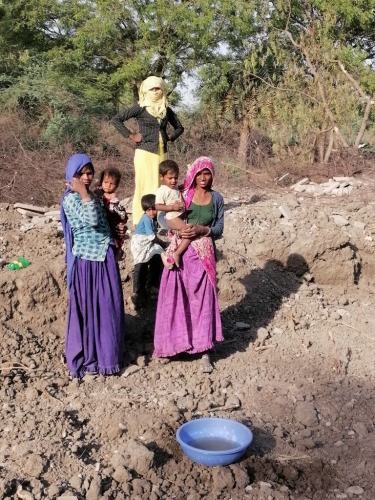
A different contractor was building the stretch between our farm and the canal and these are some of the women labourers with their children who were employed.

Labouring on our section of the waterway we had a group of eight young men from around Firozabad in Uttar Pradesh who camped under a black plastic tent. They were provided with drinking water, flour, dal, onions and potatoes and cooked a morning meal and an evening meal everyday on a wood camp fire and took it in turns to do the cooking. A water tank pulled by a tractor came with water for bathing. They had no toilet facilities. We gave them organic tomatoes from our bounteous harvest. They worked from very early each morning till sunset, with rest periods during the day waiting for the concrete mixer or water tanker to arrive.
Once the trench was ready, a concrete raft was laid and the men put up form work on the concrete raft for the waterway side walls and filled it with concrete; they then laid the next section of the concrete raft; in the evening or early next morning they dismantled the shuttering and assembled it again on the extended raft. And so it progressed, first in 20-meter and then 30-meter sections, day after day.
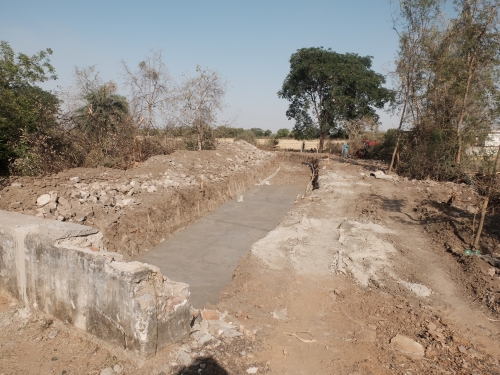

Small concrete mixers brought the concrete from a nearby open air central area beside the minor waterway where the cement, sand and aggregate were kept and mixed. For water they had bored a tubewell. Once the shuttering was removed, the sides were covered with jute sacks and a water tanker came to wet them and cure the cement.
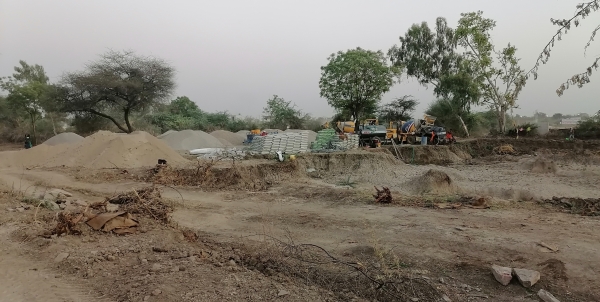
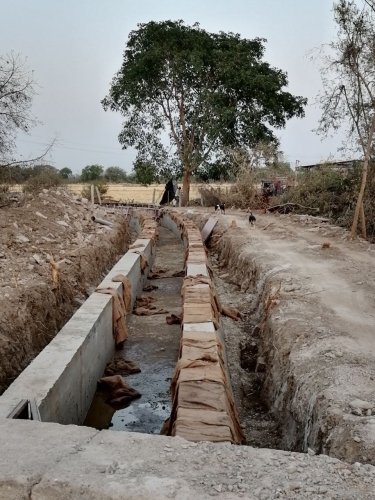

Meanwhile the farm work was going on. The piles of handcut wheat chaff called bhoussa was picked up from the fields by a team of tribals who camp near here at the Khera-Rasulpura road T-junction during the harvesting season. It was stored in the bhoussa ghar and loaded in through the roof after the tiles have been removed. Half was kept for our cows and half was sold and removed off the farm in bulbous trolley loads by a Gurjar family. The price had increased to Rs.2000/bigha. The cow herders are competing with the factory furnaces which find agricultural waster cheaper than other fuels to the detriment of the cows.
The tiles were put back and broken ones replaced. By the end of April the wheat had been harvested but not sold as there was a logjam at the mandi and tractors hitched to trollies were queueing for hours. Here the wheat is stored under thick plastic tirpals (sheets) waiting for the situation to ease. A bumper wheat crop everywhere this year by all accounts, but the combined wheat grown in a wheat-rice pattern every year is riddled with the weed gulli danda or Phalaris minor (see March 2025 blog) and will need winnowing. Our wheat grown in rotation sunnhemp-mustard and then rice-wheat over two years is clean and had no weeds and no herbicides or pesticides were used on it.

Death and Destruction had advanced through the farm and they expect to have finished by the end of May. We hope that some of the felled trees will regrow and our Butterfly Walk will be restored within a few years.

On the Farm - March ’25
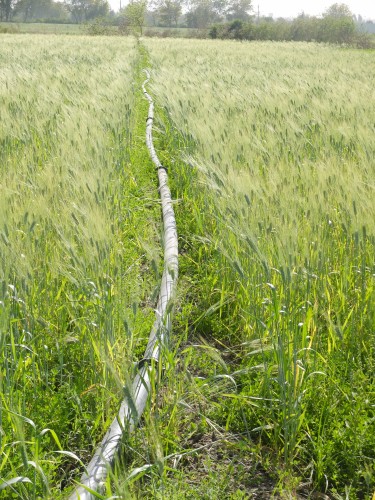 March marks the transition from spring to summer and the mustard harvest. We had no rain and the wheat was watered with pipes. This is an efficient use of water taking it to exactly where it is needed and avoiding flooding and over watering. If you look carefully you can see the smaller height of the wheat and a taller feathery layer of prolific weed which has appeared for the first time. It is called gulli danda locally and is Phalaris minor. It is a big problem in northern India and has become resistant to the herbicides sprayed on it. Rotation and baking the soil in the summer (solarisation) is the solution, but most farmers pursue a wheat-rice cropping pattern year after year which makes it hard to defeat this weed.
March marks the transition from spring to summer and the mustard harvest. We had no rain and the wheat was watered with pipes. This is an efficient use of water taking it to exactly where it is needed and avoiding flooding and over watering. If you look carefully you can see the smaller height of the wheat and a taller feathery layer of prolific weed which has appeared for the first time. It is called gulli danda locally and is Phalaris minor. It is a big problem in northern India and has become resistant to the herbicides sprayed on it. Rotation and baking the soil in the summer (solarisation) is the solution, but most farmers pursue a wheat-rice cropping pattern year after year which makes it hard to defeat this weed.
The wheat was closely guarded at night - all night, every night - mainly against blue bulls. The person on duty would flash their torch now and then, sit by a little fire as the nights were cool and we baked potatoes in the hot ashes.

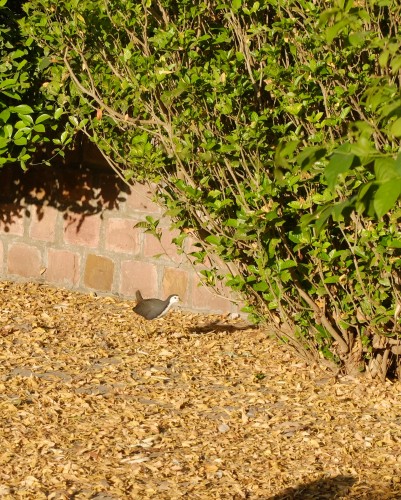 March is breezy and perennial trees such as neem lose their leaves and grow new ones without missing a beat.
March is breezy and perennial trees such as neem lose their leaves and grow new ones without missing a beat.
The waterhens have become quite numerous and are extremely noisy with their combination of clucks and repetitive calls. This one is scampering through a layer of neem leaves.

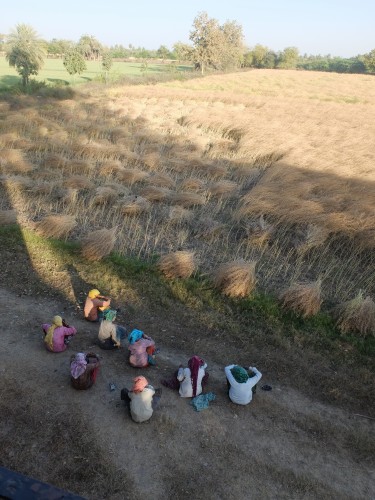 Mustard harvesting takes place in March. Some officials came to ask us to mark out a patch of mustard 15' x 15' and to hand cut it separately, hand thresh it and weigh the seeds. We did that and the mustard seeds weighed 7.2 kgs. Pioneer, the hybrid seed company, claim an average of 6.46 kgs. for this patch size. We also measured the residue straw out of interest, and it weighed 15.05 kgs. There were no gales in March, or storms, and the crops were not flattened.
Mustard harvesting takes place in March. Some officials came to ask us to mark out a patch of mustard 15' x 15' and to hand cut it separately, hand thresh it and weigh the seeds. We did that and the mustard seeds weighed 7.2 kgs. Pioneer, the hybrid seed company, claim an average of 6.46 kgs. for this patch size. We also measured the residue straw out of interest, and it weighed 15.05 kgs. There were no gales in March, or storms, and the crops were not flattened.
The team of eight mustard cutting women started cutting on 6th March and finished threshing on 23rd March. Here they are having a break, and surveying the results of their immense efforts I presume. The mustard is hand cut and placed in small bundles on top of the rigid stalks to dry. It is then collected in arm fulls and piled in a number of huge heaps called gallas in the fields and threshed in a thresher. For example, there could be roughly five gallas in a one hectare. You can see the cut bundles in the field extending in front of the women.
On 21st March the first mustard was threshed and on 23rd at 10:30am it finished. The bhoussa (chaff) sold for Rs.1293 a bigha which was a big increase over last year. The mustard sold for Rs.5961 per quintal (100 kgs.) which was the best price this year at the mandi. We sold 8327 kgs. from 29 bighas which is 287 kgs. a bigha which was much better than last year when yields were very low but not as high as previously.

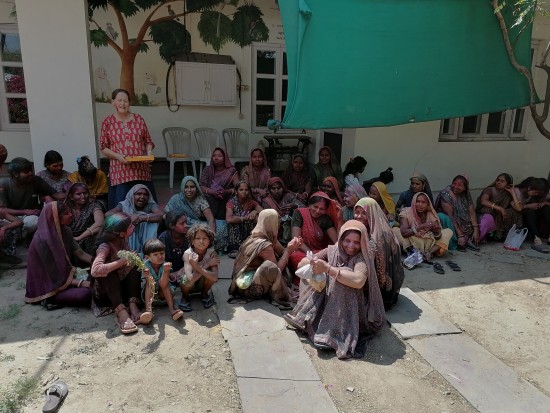 The women stopped harvesting for Holi on the 14th and a gang of 34 women and children came to dance and sing and greet us. They visited all the houses in the village where a person had died in the previous year which was about 14. The tradition of applying colour to a widow’s face and or feet as a sign of the end of mourning has been taking place every year and I have only just learnt about it. It happens in towns as well. I recently visited a widowed friend after Holi and one of her many dogs was alarmed when I stood upto go and ran at me and bit my shin to scrape the skin. Although there was no blood, there is a lot of rabies about in Kota, and a course of five anti-rabies jabs was recommended. I went to the former Zenana hospital in the old city. Very impressive. The staff were friendly, helpful and efficient and it was all free.
The women stopped harvesting for Holi on the 14th and a gang of 34 women and children came to dance and sing and greet us. They visited all the houses in the village where a person had died in the previous year which was about 14. The tradition of applying colour to a widow’s face and or feet as a sign of the end of mourning has been taking place every year and I have only just learnt about it. It happens in towns as well. I recently visited a widowed friend after Holi and one of her many dogs was alarmed when I stood upto go and ran at me and bit my shin to scrape the skin. Although there was no blood, there is a lot of rabies about in Kota, and a course of five anti-rabies jabs was recommended. I went to the former Zenana hospital in the old city. Very impressive. The staff were friendly, helpful and efficient and it was all free.

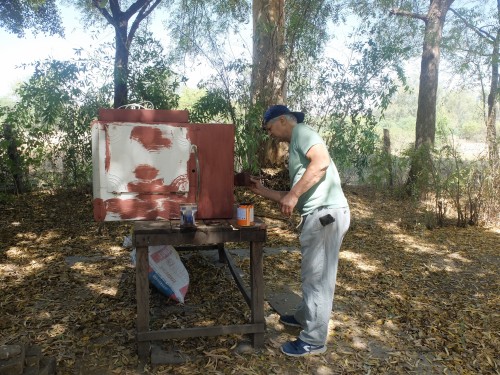 By Holi the house is starting to warm up and we need fans. Time to service the desert cooler and get it ready for non-stop use day and night. We have a mulberry tree which was laden with very small but tasty mulberries which make excellent ice-cream to enjoy on a summer’s day, or night.
By Holi the house is starting to warm up and we need fans. Time to service the desert cooler and get it ready for non-stop use day and night. We have a mulberry tree which was laden with very small but tasty mulberries which make excellent ice-cream to enjoy on a summer’s day, or night.

 And to end with a photograph of our Amaryllis, or Easter Lillies as we call them, looking magnificent in the morning sun as we ate breakfast in the garden. Night temperatures ranged from 11oC - 20oC in March and by the end of March it was too hot for breakfast outside. This peacock comes every morning to drink and allows us to to sit quietly having breakfast and marvel at his magnificience.
And to end with a photograph of our Amaryllis, or Easter Lillies as we call them, looking magnificent in the morning sun as we ate breakfast in the garden. Night temperatures ranged from 11oC - 20oC in March and by the end of March it was too hot for breakfast outside. This peacock comes every morning to drink and allows us to to sit quietly having breakfast and marvel at his magnificience.

On the Farm - February ’25
February is a month we look forward to with breakfast and lunch outside and very pleasant sunny weather. It did not rain once in February and we had our last log fire on 10th February to greet visitors and then capped the chimney to stop parrots nesting there and squirrels dropping into our drawing room. Night temperatures ranged from 9oC - 15oC and daytime 22oC - 30oC.

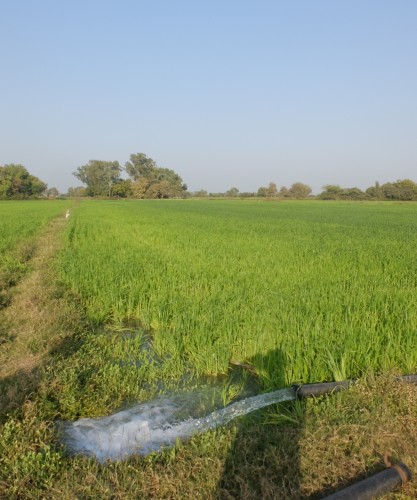 The main activities are watering the wheat for the 2nd time which develops its ears this month and is very vulnerable to wildlife attacks. Every night Vijay was up chasing a herd of up to twelve nilgai out of the wheat fields. They hide in the tall mustard in the adjoining fields and sneak back later. The mustard dried out in February and will be cut in early March, stacked and threshed thereafter.
The main activities are watering the wheat for the 2nd time which develops its ears this month and is very vulnerable to wildlife attacks. Every night Vijay was up chasing a herd of up to twelve nilgai out of the wheat fields. They hide in the tall mustard in the adjoining fields and sneak back later. The mustard dried out in February and will be cut in early March, stacked and threshed thereafter.
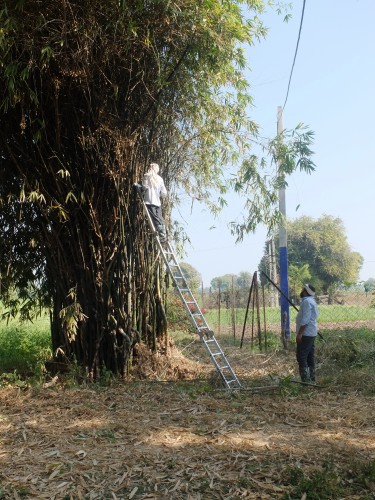 One job was trimming the bamboo clump which tends to interfere with the electricity wires and has to be kept in check.
One job was trimming the bamboo clump which tends to interfere with the electricity wires and has to be kept in check.
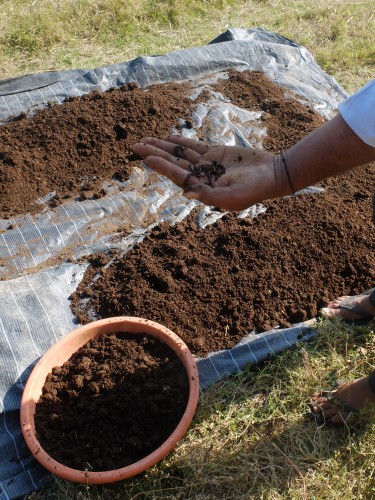 Another job was drying out the vermi compost, picking out the worms and refilling the bed with fresh gobar and bhoussa so they could get going chomping up more organic compost for the vegetables.
Another job was drying out the vermi compost, picking out the worms and refilling the bed with fresh gobar and bhoussa so they could get going chomping up more organic compost for the vegetables.

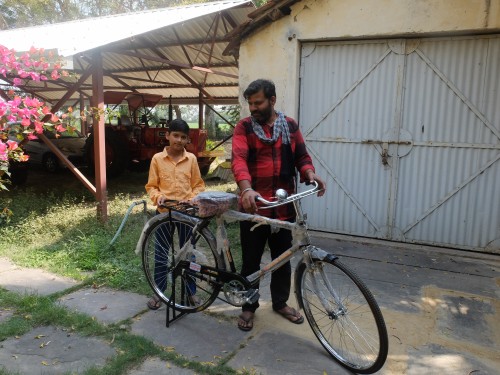 A neem tree trunk which had been cut and dried out was taken to the sawmill in Kaithoon and 31/2" x 11/2" planks made from it. On the same trip a new bicycle was purchased for use by Dinesh and his old one was renovated at his expense and we passed over the ownership to his son, Gautam. A new, very basic India made bicycle costs Rs. 5200 or GBP 55.
A neem tree trunk which had been cut and dried out was taken to the sawmill in Kaithoon and 31/2" x 11/2" planks made from it. On the same trip a new bicycle was purchased for use by Dinesh and his old one was renovated at his expense and we passed over the ownership to his son, Gautam. A new, very basic India made bicycle costs Rs. 5200 or GBP 55.

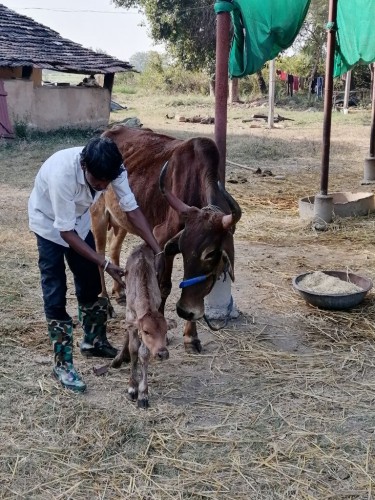 A new calf was born, the first one for eight months - another male. We have called him Kumbh as he was born during the Maha Kumbh Mela in which 1/3 of the population of India is said to have taken a dip in the holy river Ganges.
A new calf was born, the first one for eight months - another male. We have called him Kumbh as he was born during the Maha Kumbh Mela in which 1/3 of the population of India is said to have taken a dip in the holy river Ganges.
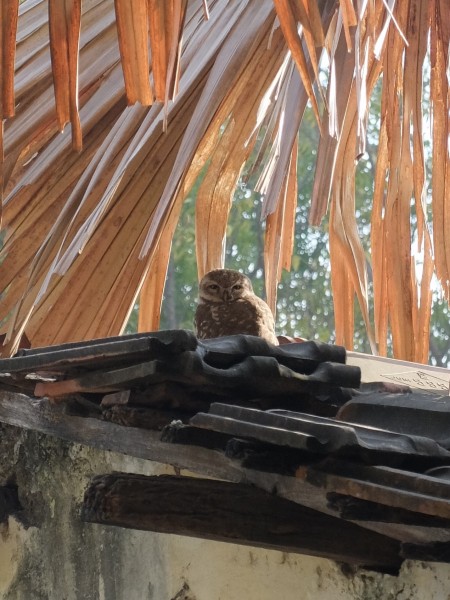 Another resident of the farm is this spotted owlet which was perched on the garage roof under a protective awning of dried palm leaves.
Another resident of the farm is this spotted owlet which was perched on the garage roof under a protective awning of dried palm leaves.

 And to finish with, the greens of February. The light green in the middle is deshi wheat of C306 and Bansi varieties. Behind it is the brighter green of berseem (Egyptian clover: Trifolium alexandrinum) fodder for the cows. Commercial wheat 4037 is in the field in the distance. The tall tree on the right losing its slightly golden leaves is a neem tree (Azardirachta indica). The almost bare tree on the left with long pods is a gulmohur (Delonix regia). Darker green banana leaves can be seen in the foreground on the right. The red clusters of flowers are Clerodendrum variety, with white being Bougainvillea.
And to finish with, the greens of February. The light green in the middle is deshi wheat of C306 and Bansi varieties. Behind it is the brighter green of berseem (Egyptian clover: Trifolium alexandrinum) fodder for the cows. Commercial wheat 4037 is in the field in the distance. The tall tree on the right losing its slightly golden leaves is a neem tree (Azardirachta indica). The almost bare tree on the left with long pods is a gulmohur (Delonix regia). Darker green banana leaves can be seen in the foreground on the right. The red clusters of flowers are Clerodendrum variety, with white being Bougainvillea.

On the Farm - January ’25
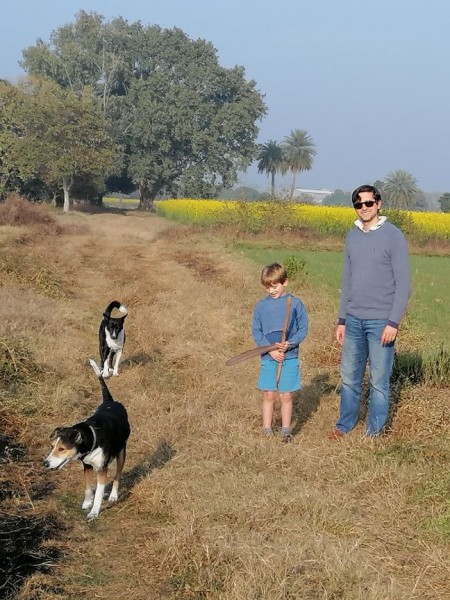 Our son Anand, and six-year old grandson Arthur, were here until 3rd January and we booked a safari at Ranthambore Wildlife Sanctuary. It turned out to be a glorious clear day after a misty start and we saw tiger pug marks in the soft mud but no tigers.
Our son Anand, and six-year old grandson Arthur, were here until 3rd January and we booked a safari at Ranthambore Wildlife Sanctuary. It turned out to be a glorious clear day after a misty start and we saw tiger pug marks in the soft mud but no tigers.
The outing nearly turned into a disaster when a malevolent bull by the entry to the sanctuary tried to toss Arthur as we walked back to our car. Anand showing amazing presence of mind and reaction whisked Arthur through the air in a circular movement away from the bull so that the bull’s horn caught and ripped Arthur’s clothes and Arthur received a surface skin wound on the back of this right rib cage but more serious damage was prevented though the impact was painful.
Anand and Arthur later missed their international flight from Delhi to London due to their Jaipur-Delhi flight being delayed and had to buy new tickets via Mumbai in order to be back in the UK for Anand to chair an 8.00am meeting on 5
All that will linger in our memories for a long time, if not forever!

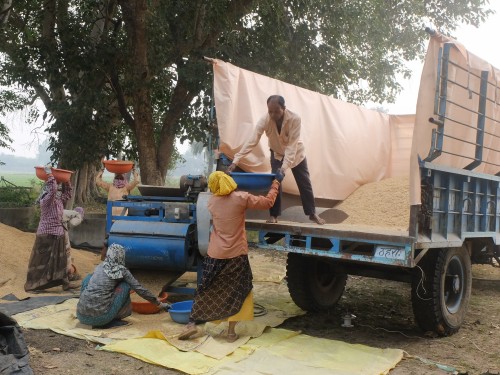 The first two weeks of January are the coldest in the year and the trolley loading team wasn’t prepared to work in such weather as it was thick mist through most of the day. The temperature did not fall below 7oC this year and reached a maximum of 12oC on sunless days, or mid-20’s by the end of January. The big disappointment was the low price of rice which was only 57-64% of last year’s. We had our best yield ever but at 2018 prices. There is a difference in price for combine harvested vs. hand cut rice which is cleaner and fetches a higher price. To get a higher price the team of women feed the the rice through a winnowing machine that shakes out all the chaff and tiny balls of soil. The trolley is then loaded and leaves for the market the following morning where the rice is dumped in a pile and the trolley comes back to be reloaded. No one stays to guard the rice pile or with nothing to do any attendants are tempted to start drinking. The buyers go from pile to pile bidding and the highest bidder gets the pile. It is then bagged and weighed into 49-50kg. sacks. Some of the sale price goes to the men who do the bagging and weighing and some to the women who sweep and help. It now costs Rs.1500 for the tractor-trolley and driver to take the rice to the market.
The first two weeks of January are the coldest in the year and the trolley loading team wasn’t prepared to work in such weather as it was thick mist through most of the day. The temperature did not fall below 7oC this year and reached a maximum of 12oC on sunless days, or mid-20’s by the end of January. The big disappointment was the low price of rice which was only 57-64% of last year’s. We had our best yield ever but at 2018 prices. There is a difference in price for combine harvested vs. hand cut rice which is cleaner and fetches a higher price. To get a higher price the team of women feed the the rice through a winnowing machine that shakes out all the chaff and tiny balls of soil. The trolley is then loaded and leaves for the market the following morning where the rice is dumped in a pile and the trolley comes back to be reloaded. No one stays to guard the rice pile or with nothing to do any attendants are tempted to start drinking. The buyers go from pile to pile bidding and the highest bidder gets the pile. It is then bagged and weighed into 49-50kg. sacks. Some of the sale price goes to the men who do the bagging and weighing and some to the women who sweep and help. It now costs Rs.1500 for the tractor-trolley and driver to take the rice to the market.
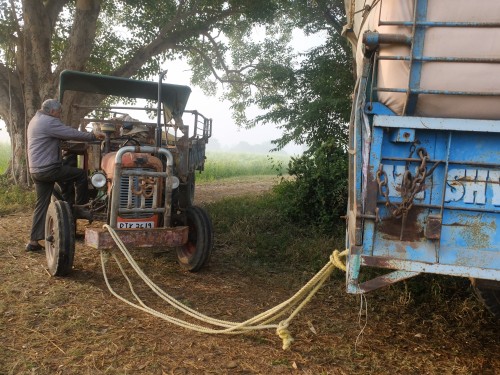 The first trolley load was sold on 6the January to test the market and was sold for Rs.2200/100kgs. We had to sell though and storing until the price went up was not really an option and a gamble. The rice piles on the farm were covered in thick plastic and where moisture gets in the rice soon starts to sprout. The second trolley load was sold on the 13th for Rs.2270. Last year it was Rs. 3801 for combine harvested rice. Our first trolley of hand cut rice went to the market on the 21st and sold for Rs.2636. Last year the price for hand cut was Rs.4101. On the 22nd the final two trolley loads went and the very old smaller tractor had to be tow started by the newer tractor using a rope. Instantly effective.
The first trolley load was sold on 6the January to test the market and was sold for Rs.2200/100kgs. We had to sell though and storing until the price went up was not really an option and a gamble. The rice piles on the farm were covered in thick plastic and where moisture gets in the rice soon starts to sprout. The second trolley load was sold on the 13th for Rs.2270. Last year it was Rs. 3801 for combine harvested rice. Our first trolley of hand cut rice went to the market on the 21st and sold for Rs.2636. Last year the price for hand cut was Rs.4101. On the 22nd the final two trolley loads went and the very old smaller tractor had to be tow started by the newer tractor using a rope. Instantly effective.

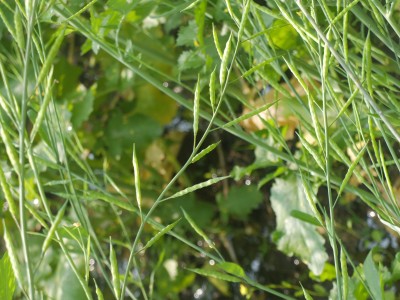 The other main crops were mustard and wheat. The mustard gradually ceased to flower as the month progressed, the mustard pods swelling in the cool weather. The mustard was watered carefully so that no plant was standing in water for too long. The weight of the crop causes the tall plants to fall over if the ground is too wet.
The other main crops were mustard and wheat. The mustard gradually ceased to flower as the month progressed, the mustard pods swelling in the cool weather. The mustard was watered carefully so that no plant was standing in water for too long. The weight of the crop causes the tall plants to fall over if the ground is too wet.
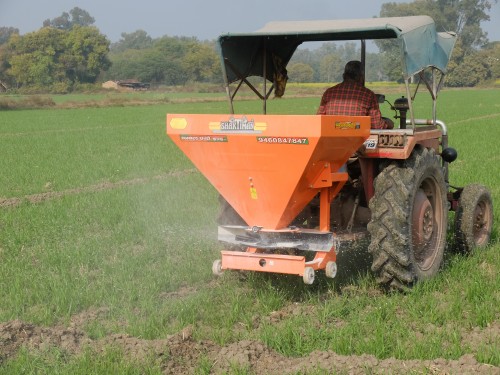 The wheat was watered after being fertilised with urea. Ghasi had bought a tractor mounted hopper attachment for spreading fertiliser etc. two years ago at a subsidised price and as he drove his tractor through the young wheat the white urea pellets were scattered evenly across the field. If done by hand the pellets go where they are thrown by skilled labour and none ends up on the verges outside the growing area. In the absence of willing and skilled labour such machinery will become the norm.
The wheat was watered after being fertilised with urea. Ghasi had bought a tractor mounted hopper attachment for spreading fertiliser etc. two years ago at a subsidised price and as he drove his tractor through the young wheat the white urea pellets were scattered evenly across the field. If done by hand the pellets go where they are thrown by skilled labour and none ends up on the verges outside the growing area. In the absence of willing and skilled labour such machinery will become the norm.
Here is a short video (4.6MB) of the hopper contraption in action. Go full screen for a better view.

We had some drizzle in the middle of the month after a few sunless days and the stone walls became very cold. It was very chilly inside and we wore caps and jackets. On the 19th the sun came through and warmed the roof and external walls that had no verandahs. By the afternoon we noticed tiny puddles of condensation collecting on the floor and condensation ran down the interior bedroom walls upstairs. We have not noticed this before. Others with cold solid stone walls also experienced the same phenomenon in the high humidity. Luckily, all walls are painted with wipeable emulsion; wallpaper is not practical.

Following Tigger’s death in December, the farm manager Ghasi’s mother died on 29th January. She had lived in one of our simple cottages in the 1970’s and brought up her large family while working non-stop both in the fields and at home. Her eldest son was hard working and enterprising and bought land near Tonk about three-hours away by motorbike. She spent her declining years there as a widow looked after by sons and daughters-in-law and grandchildren. She was probably in her late 70’s but was said to be at least 90. When the news came that she had died, our cow man, the tractor driver and one of the workers left at 5.00am on a small motorbike to attend the funeral. Three hours in each direction. In Ghasi's absence Vijay had to protect his fields from the dozen or so nilgai deer that tried to graze on the young wheat every night. Exhausting, with his alarm set every two hours through the night. One particular lone bull kept coming in at night and finally was caught and loaded into a van and released in the jungle, there being no legal means of dealing with stray cattle.

One particular religious event, the largest in the world, has been going on since 13the January and will last 45 days. The Maha Kumbh Mela happens every twelve years at the confluence of three rivers at Prayagraj in Uttar Pradesh. The authorities were expecting 400 million to attend and take a holy dip (by 12th February 480 million had attended). Sugna, our maid, and 14 family members set off in a bus for Ayodhya on Sunday, 26th January. They were stopped from going to Ayodhya, the birth place of Ram, but attended the Kumbh. She claims they left the bus at 10.00am and a van took them the first 10 kms. They had to walk 40 kms. (?) between ropes keeping together until 6.00pm. There were stops for toilets, drinking water and food. Motorbikes offered to take them for Rs.500 per passenger, but they all kept together and walked. They left the river at 7.00pm and set off walking back to the bus arriving at 6.00am. Their whole group reached the bus alive but many collapsed on the way. The pilgrimage was done in the spirit of accepting the chance of dying and feeling blessed to have died there.
 For those who did not go, kite flying was a seasonal activity culminating in Makar Shankranti on 14th January. Here Gautam flies a captured kite (a loose kite that had floated in with the wind), in perfect kite flying weather.
For those who did not go, kite flying was a seasonal activity culminating in Makar Shankranti on 14th January. Here Gautam flies a captured kite (a loose kite that had floated in with the wind), in perfect kite flying weather.

On the Farm - December ’24
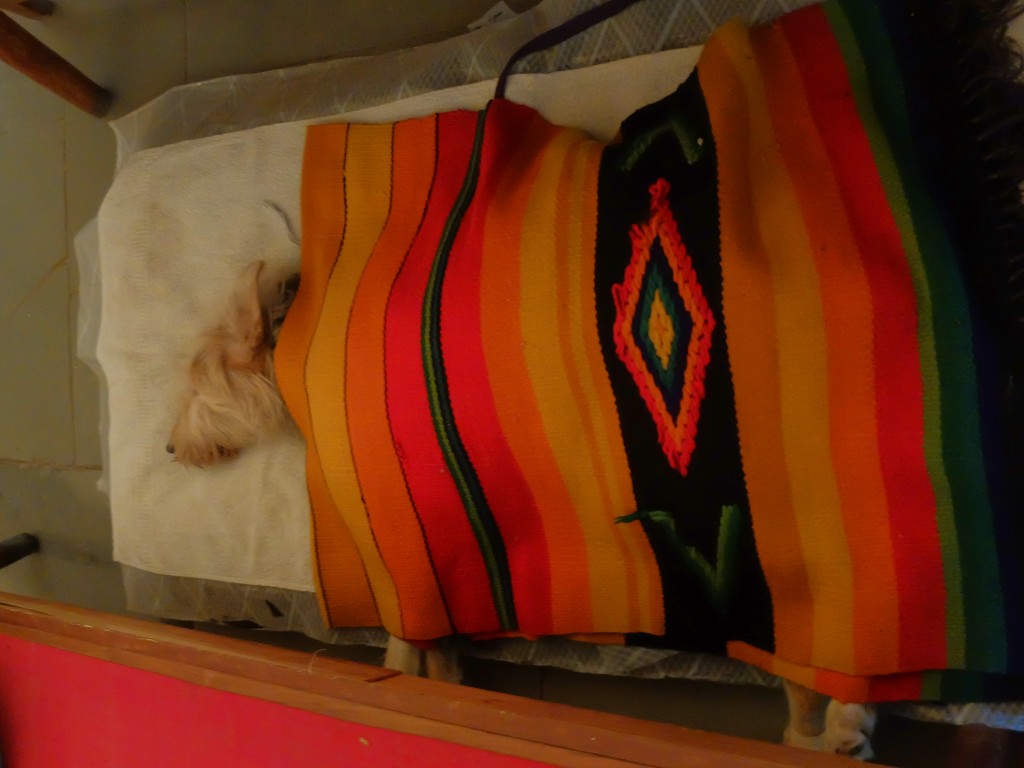 The December blog is devoted to Tigger who struggled on but became weaker and weaker and finally breathed his last at 3:13am on 20th December. By 6th December he could not get up by himself but could walk outside with assistance. On the 8th, while outside in the sun, he suffered some sort of stroke or seizure and from then on needed to be carried in and out but refused to give up. His painful joints became worse as the cold increased and he couldn’t even manage to eat tiny slivers of liver which had kept him going for a year. His final days were cold but sunny and he chose a perfect day to leave us - the mustard was in full flower and the sky clear and blue.
The December blog is devoted to Tigger who struggled on but became weaker and weaker and finally breathed his last at 3:13am on 20th December. By 6th December he could not get up by himself but could walk outside with assistance. On the 8th, while outside in the sun, he suffered some sort of stroke or seizure and from then on needed to be carried in and out but refused to give up. His painful joints became worse as the cold increased and he couldn’t even manage to eat tiny slivers of liver which had kept him going for a year. His final days were cold but sunny and he chose a perfect day to leave us - the mustard was in full flower and the sky clear and blue.

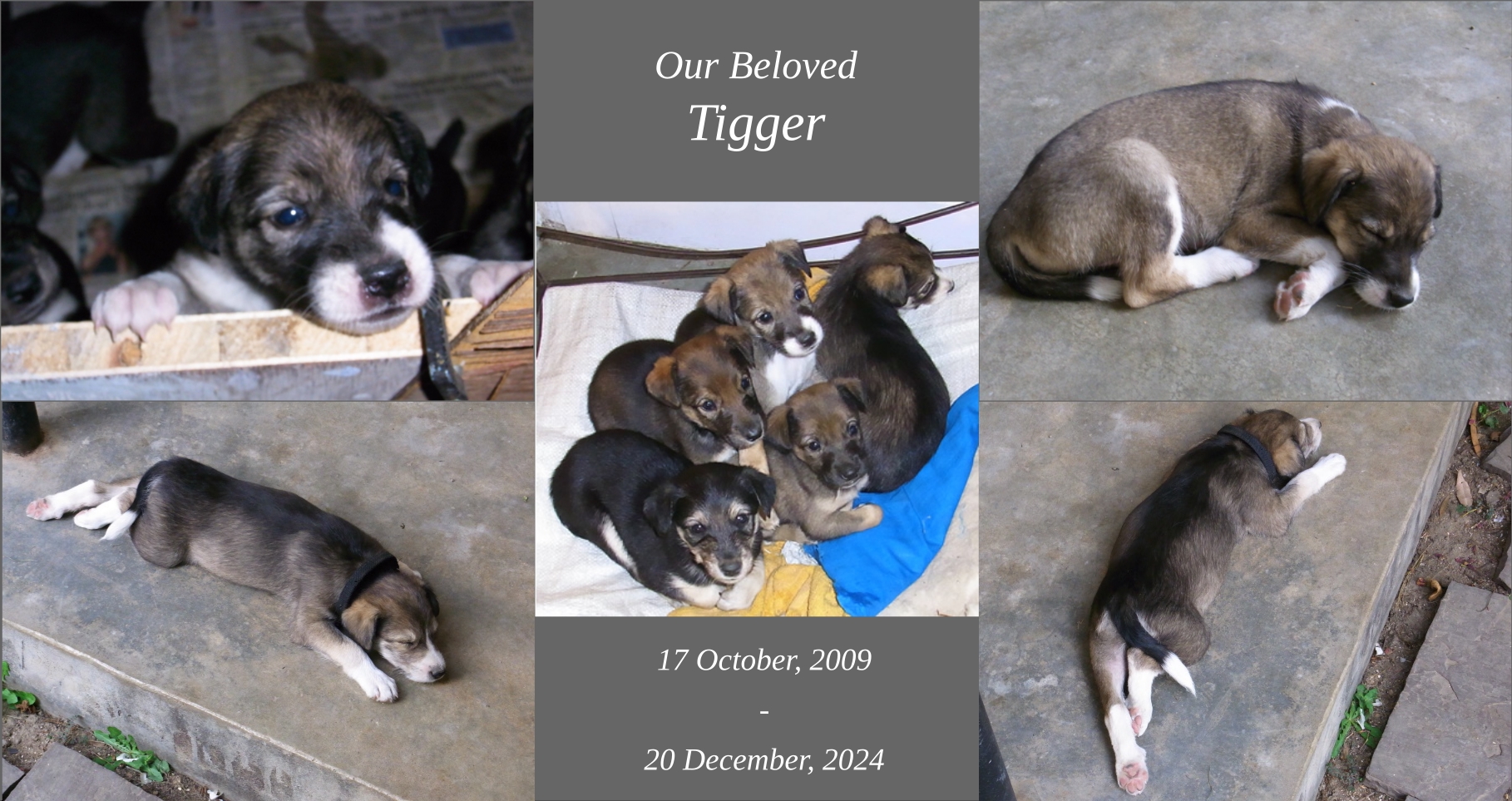 Here is the first photograph of Tigger with his siblings from October 2009 along with photographs taken not long after as he was growing up.
Here is the first photograph of Tigger with his siblings from October 2009 along with photographs taken not long after as he was growing up.
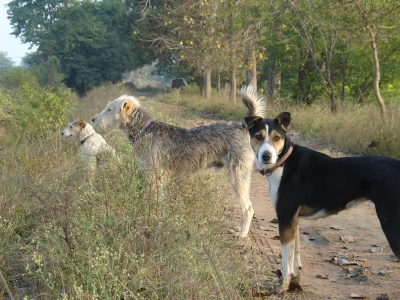 Here he is from 2014 (middle) with his mother Anjelica and niece Lucy (black). His father had been Sheru, the German shepherd on the next farm which explains his size.
Here he is from 2014 (middle) with his mother Anjelica and niece Lucy (black). His father had been Sheru, the German shepherd on the next farm which explains his size.

Tigger had an incident packed life and was gored by a pig at least twice. He liked to catch piglets and hold onto them until summoned by squeals we arrived to dispatch the poor creature to augment his daily diet of organic chappatis, scrambled eggs and home produced milk.
His relationship with the other dogs was very complex. He bullied Lucy and she couldn’t walk past him without an escort but she had ganged up with Doosra and attacked and wounded him on more than one occasion and for a long time he hardly dared go outside without an adult guard.

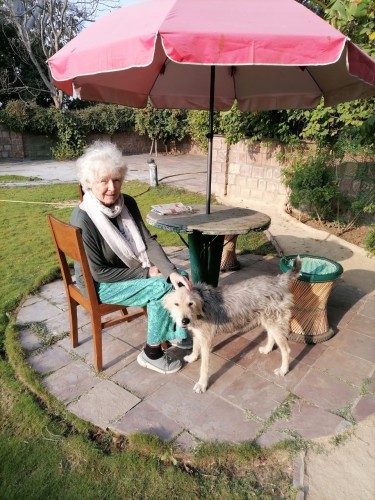 Tigger saw protecting women as his main job in life and attached himself to female friends and visitors alike right up to his last days. He would follow me from room to room with no encouragement or reward and accompanying me on our daily walk around the farm was highlight of his day. His greatest supporter and regular visitor Sue Millar seen here with Tigger penned the doggerel ode below.
Tigger saw protecting women as his main job in life and attached himself to female friends and visitors alike right up to his last days. He would follow me from room to room with no encouragement or reward and accompanying me on our daily walk around the farm was highlight of his day. His greatest supporter and regular visitor Sue Millar seen here with Tigger penned the doggerel ode below.
Now Tigger was a very good dog
And a mighty fine dog was he.
He knew all the things a dog should do
And just how a dog should be.
His place on the farm he knew right well
And every green plant and tree.
The birds and animals knew him too
As lord of the land and free.
But all good things must come to an end
And Tigger the same as the rest.
He’s joined his sister in canine heaven
But dogwise he’s just the best.

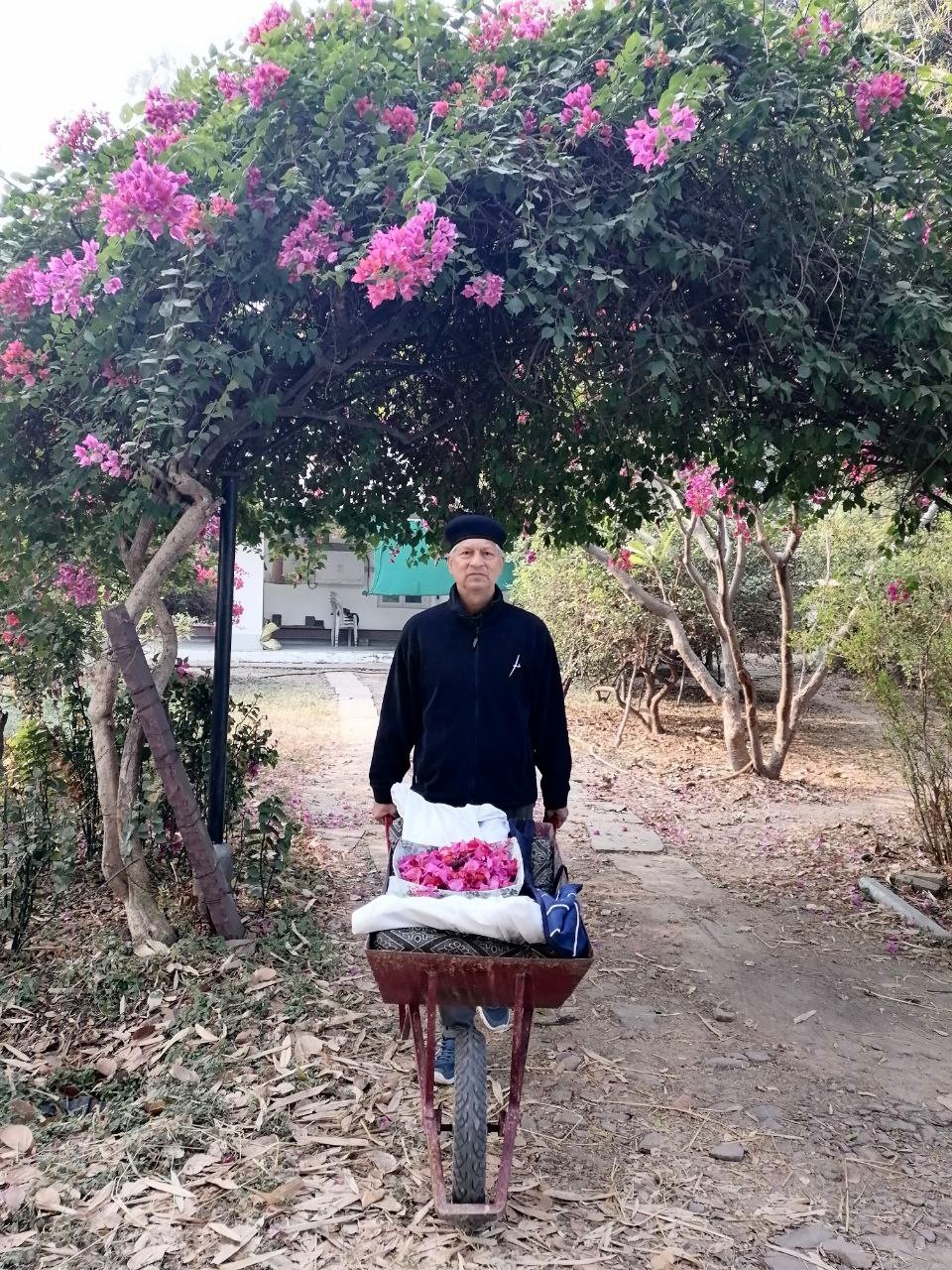
 Tigger’s final journey was at 10:00am on 20th December as he was trundled to the prepared grave close to his relations. We strew bougainvillea on his body in silence, united in sadness.
Tigger’s final journey was at 10:00am on 20th December as he was trundled to the prepared grave close to his relations. We strew bougainvillea on his body in silence, united in sadness.

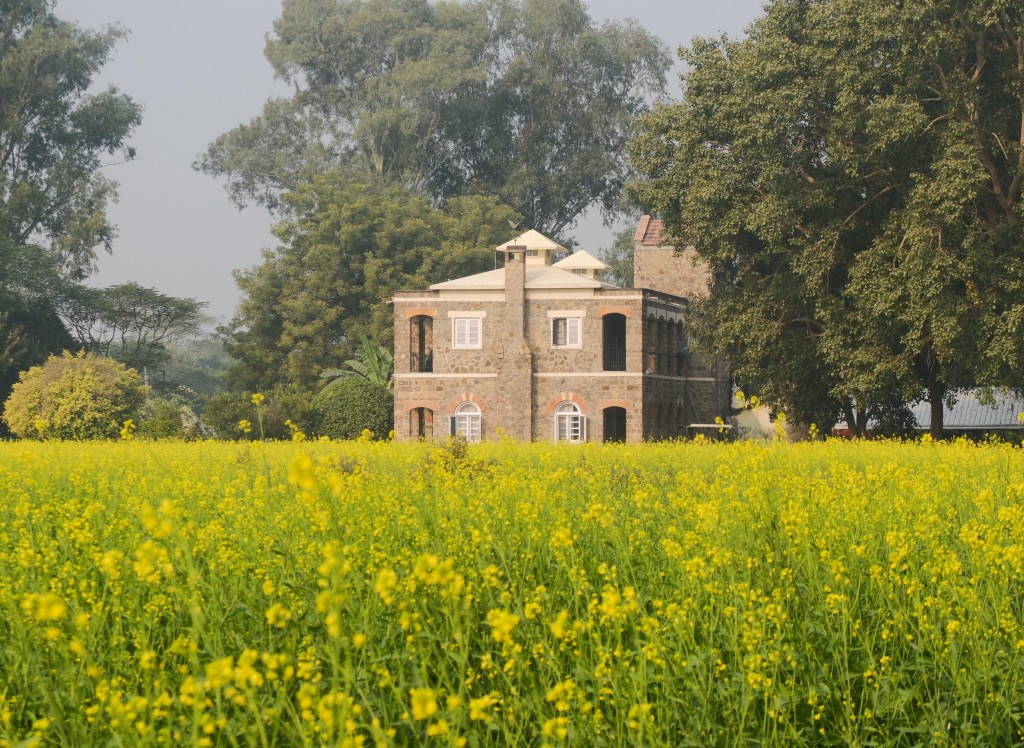 The view of the house from the grave could not have been better. Mustard is only planted there every two years and flowers for the brief winter period.
The view of the house from the grave could not have been better. Mustard is only planted there every two years and flowers for the brief winter period.

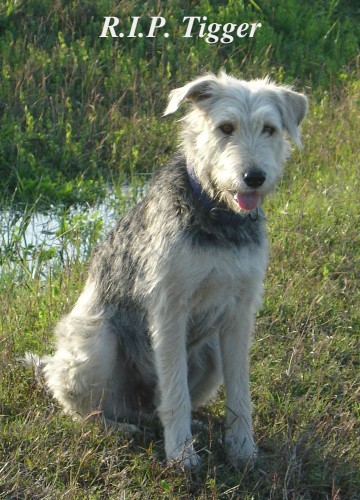

On the Farm - November ’24
November started in the middle of Diwali. We celebrated Govardhan Puja on the 2nd. Here are the two gobar figures of Krishna and his brother, Balram, waiting for the puja to start. This puja is done by the women and the cow puja, which honours cows as a source of wealth is done by men and both were carried on at the same time.
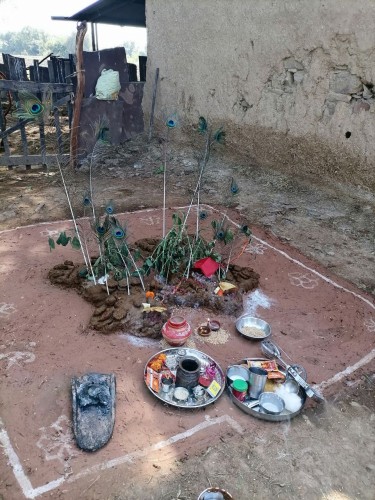
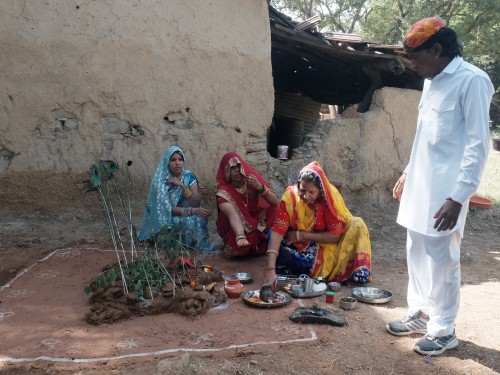
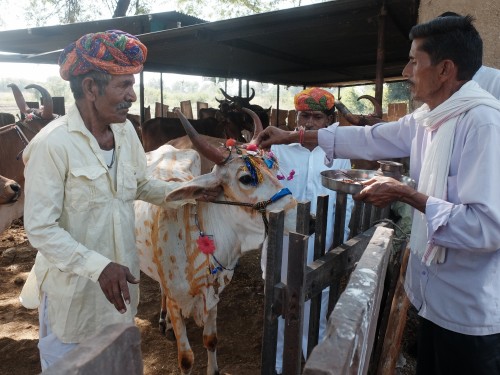 Here a tikka is being placed on Tikku’s forehead. Her horns have been oiled with linseed oil as have her hooves. The decorated cows are fed sweetened puris and most of them look forward to the annual treat.
Here a tikka is being placed on Tikku’s forehead. Her horns have been oiled with linseed oil as have her hooves. The decorated cows are fed sweetened puris and most of them look forward to the annual treat.

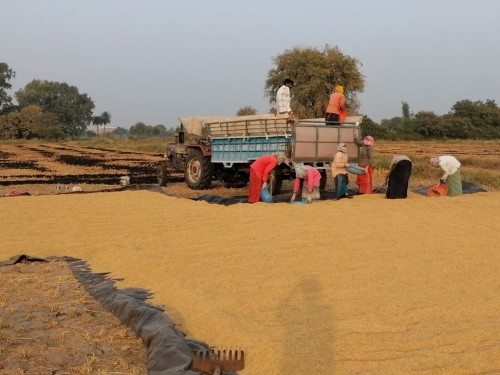 In November the rice was harvested, most by combine and some by hand by a team of seven women. Some of the combined rice was spread out to dry on the 7th in a field and loaded up and brought up to the house on the 18th. The straw had already been sold and had been raked up and loaded into trolleys to trundle away. In the hand cut field the straw was in piles where the rice had been threshed and the seven women loaded three trolleys a day so the pral (straw) could be stored by the cow shed to be used as cow fodder. The last wisps of straw still remaining in the field are burnt so the field can be ploughed and watered ready for wheat. It is illegal to burn all the straw but it is still commonplace in certain rice growing areas.
In November the rice was harvested, most by combine and some by hand by a team of seven women. Some of the combined rice was spread out to dry on the 7th in a field and loaded up and brought up to the house on the 18th. The straw had already been sold and had been raked up and loaded into trolleys to trundle away. In the hand cut field the straw was in piles where the rice had been threshed and the seven women loaded three trolleys a day so the pral (straw) could be stored by the cow shed to be used as cow fodder. The last wisps of straw still remaining in the field are burnt so the field can be ploughed and watered ready for wheat. It is illegal to burn all the straw but it is still commonplace in certain rice growing areas.
We had already planted mustard on 22nd and 24th October and in November it was time for the first watering. We broadcast urea, mixed with boron which is supposed to be good for the crop. Bersim had been sown for the cows and two varieties of deshi wheat - bansi and C306 - for home consumption which had no chemical fertiliser. I planted rocket and lettuce seeds which will be ready by early December, and the potatoes were planted on 1st November.
The green wheat attracts nilgai at night and they pose a problem for landowners and road users alike. On 29th November seven nilgai were chased out of the next farm and they ran across the road causing a motorcyclist to fall leading to head injuries.

Our resident injured motorcyclist, Deepak, had his leg operation privately to remove two metal rods from his leg and spent the rest of the month lying on a bed watching the cows.
Tigger, our 15-year old dog, staggered through the month with a lot of help in getting up on his feet and accompanying him.
Our 33-year old Maruti Gypsy had old age problems too and we found an expert mechanic, Vijay Pandit, who came and tinkered with the carburettor until the Gypsy started and took her away for a makeover.

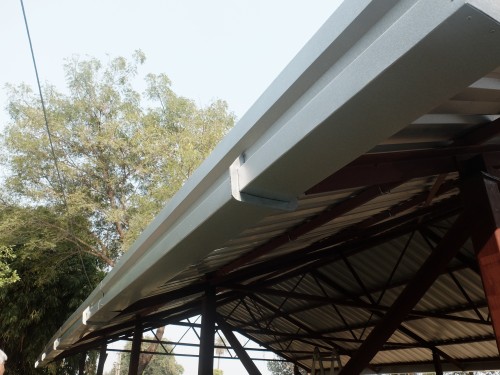 Everything is not old on our farm and the major fabrication project was completed on 15th November. The Tata Durashine roofing sheets were delivered on the 5th and afixed on top of the structure. Durashine is an aluminium/zinc alloy coating on high tensile steel which is said to last for forty years!
Everything is not old on our farm and the major fabrication project was completed on 15th November. The Tata Durashine roofing sheets were delivered on the 5th and afixed on top of the structure. Durashine is an aluminium/zinc alloy coating on high tensile steel which is said to last for forty years!
The gutter brackets were designed by Vijay and gas cut, ground and galvanised in Kota. The guttering slotted into the brackets, also secured with rivets and metal strips screwed to the purlin hooks and all metal parts were painted with red oxide.
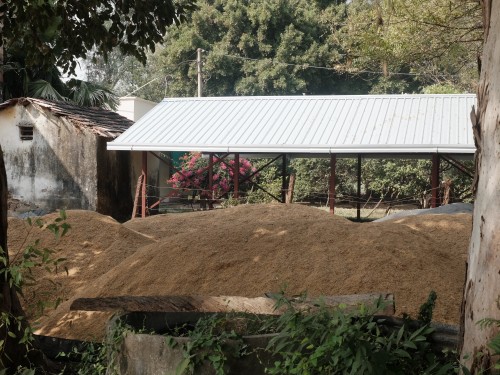 This is the new grain port waiting for the renovated Gypsy to be housed in it with piles of rice next to it waiting to be sold. They are covered in black plastic tirpals at night and whenever the piles are uncovered flocks of pigeons and parrots descend to feast.
This is the new grain port waiting for the renovated Gypsy to be housed in it with piles of rice next to it waiting to be sold. They are covered in black plastic tirpals at night and whenever the piles are uncovered flocks of pigeons and parrots descend to feast.
 Here is the happy fabricator.
Here is the happy fabricator.

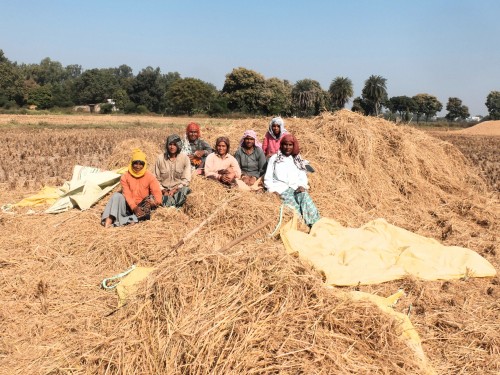 And here are the happy harvesters enjoying a rural lifestyle. They have cut rice, threshed it, loaded trolleys with grain and others with rice straw and have been employed for several weeks (click photo to enlarge).
And here are the happy harvesters enjoying a rural lifestyle. They have cut rice, threshed it, loaded trolleys with grain and others with rice straw and have been employed for several weeks (click photo to enlarge).

On the Farm - October ’24
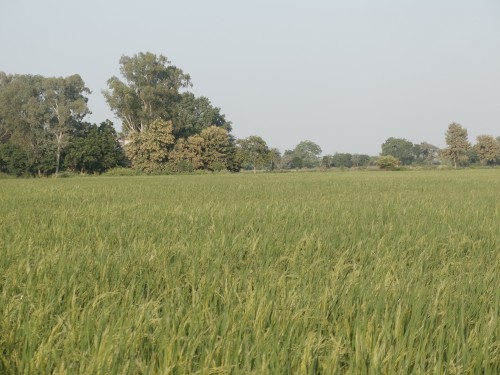
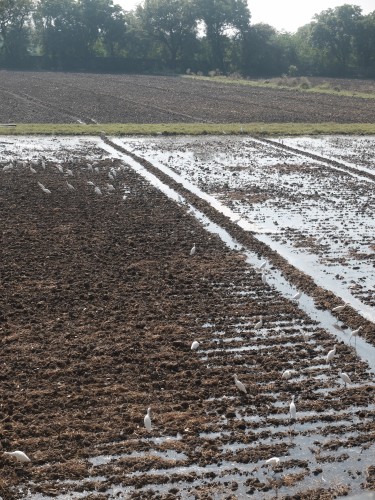
By the beginning of October the feathery rice fronds were swelling in the hot humid air of 32oC and watering was going on day and night. The fields which were to have mustard were ploughed and pre-irrigated and such ponds of water always attract pond egrets in large numbers.

It only rained on one day in the whole month and we had 0.98 cms. on 13th October. The main activity was putting up the roof of the carport-cum-grainport.
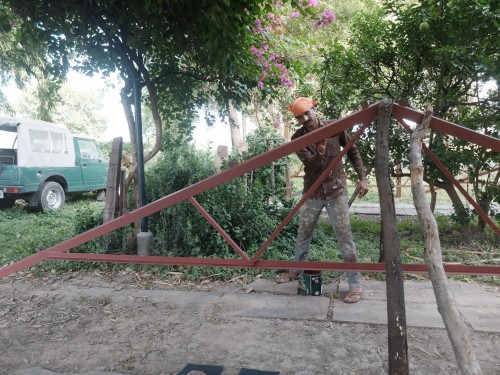 Once the painters had finished repairing the monsoon damage inside the house they began rubbing down and painting the trusses with red oxide paint.
Once the painters had finished repairing the monsoon damage inside the house they began rubbing down and painting the trusses with red oxide paint.
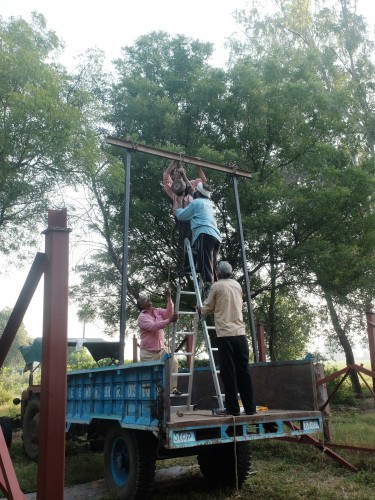 On 5th a tractor delivered the metal purlins and by 7th all had been cut to size by Vijay. In order to hoist each truss in place a block and tackle was put in position from the trailer.
On 5th a tractor delivered the metal purlins and by 7th all had been cut to size by Vijay. In order to hoist each truss in place a block and tackle was put in position from the trailer.
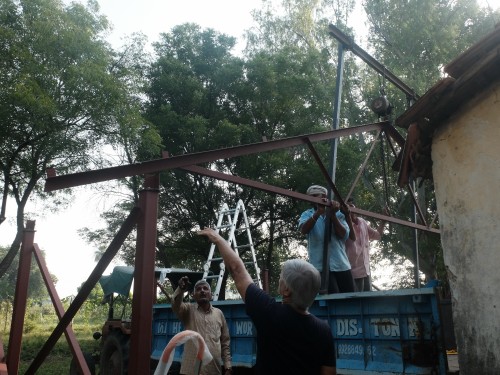
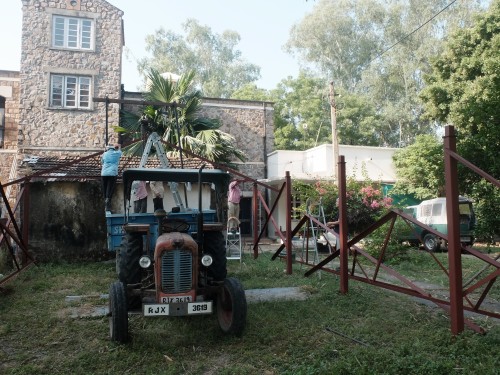
Giriraj, the welder, arrived at 8:00am and the first truss was up by 8:30am. Luckily, he had finished welding by the time the electricity went off from 11:00am to 6:15pm.
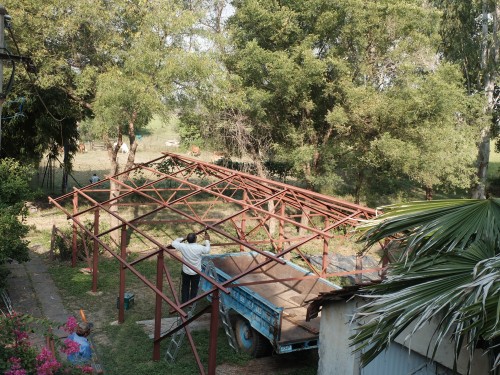 By 10th October the purlins were all rubbed down, with the slag knocked off and painted. By 20th all the welding had been finished. The next stage will be the metal roof sheets.
By 10th October the purlins were all rubbed down, with the slag knocked off and painted. By 20th all the welding had been finished. The next stage will be the metal roof sheets.

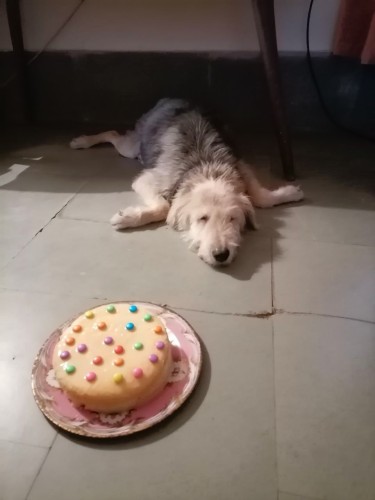 We were very happy that Tigger reached his 15th birthday on 17th October. During the nine nights or 'Navratra' leading up to Dashera the butcher had not been allowed to sell goat meat and Tigger became noticeably weaker eating chicken. His walking is increasingly wobbly and he has to be helped to stand up. No chance that he will suddenly bound up to the cake and eat it. He did enjoy his slice though.
We were very happy that Tigger reached his 15th birthday on 17th October. During the nine nights or 'Navratra' leading up to Dashera the butcher had not been allowed to sell goat meat and Tigger became noticeably weaker eating chicken. His walking is increasingly wobbly and he has to be helped to stand up. No chance that he will suddenly bound up to the cake and eat it. He did enjoy his slice though.
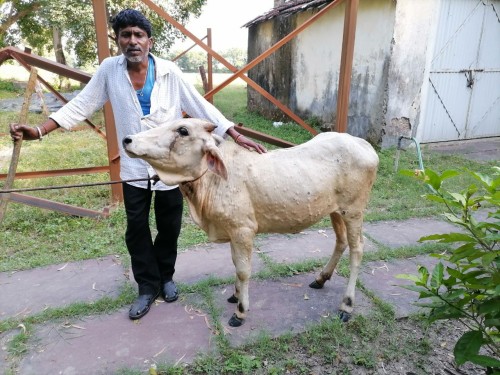 Another animal suffering from ill health this month was the calf Nandi who had developed lumpy skin disease. This is a pox that is said to be caused by a very contagious virus. No other cows in the area had it or indeed caught it and so the actual mechanics of contagion are rather mysterious. The pox were painted with iodine and thanks to anti-biotics and anti-allergy tablets Nandi gradually recovered.
Another animal suffering from ill health this month was the calf Nandi who had developed lumpy skin disease. This is a pox that is said to be caused by a very contagious virus. No other cows in the area had it or indeed caught it and so the actual mechanics of contagion are rather mysterious. The pox were painted with iodine and thanks to anti-biotics and anti-allergy tablets Nandi gradually recovered.

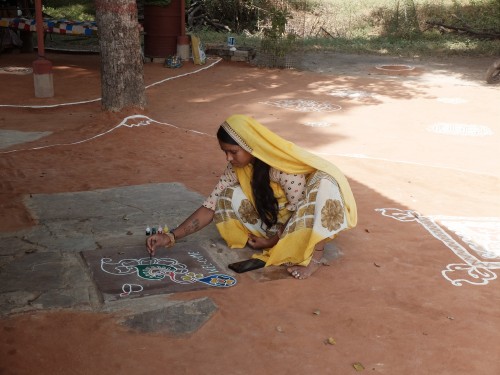 Navratra and Dashera are part of the festival calendar leading up to Diwali which was on 31st October. The leepna was redone around our house and Chandni and Shyam redid the leepna in front of their houses and painted designs on the walls and prepared ground. This photo marks a sociological change in the tradition. Designs were traditional to a village or area and passed on from mother to daughter. Chandni is copying a design from her phone. She has every design in the world to choose from and the one she is working on is probably a selection of designs to be drawn in mehendi (henna) on hands, arms and legs. She has acquired poster colours from somewhere rather than coloured powder and is developing the possibilities of decorating for Diwali according to her own tastes.
Navratra and Dashera are part of the festival calendar leading up to Diwali which was on 31st October. The leepna was redone around our house and Chandni and Shyam redid the leepna in front of their houses and painted designs on the walls and prepared ground. This photo marks a sociological change in the tradition. Designs were traditional to a village or area and passed on from mother to daughter. Chandni is copying a design from her phone. She has every design in the world to choose from and the one she is working on is probably a selection of designs to be drawn in mehendi (henna) on hands, arms and legs. She has acquired poster colours from somewhere rather than coloured powder and is developing the possibilities of decorating for Diwali according to her own tastes.

On the Farm - September ’24
September wasn’t an unduly wet month and only 11.43 cms. of rain fell, mainly in the first week. There was flooding and heavy rain in many places in Rajasthan but not here. The rice was watered with the pumps going day and night and rogue tall rice plants were removed by hand. The sunnhemp grown for green manure attained a height of at least 6 feet and needed ploughing in, which it was.

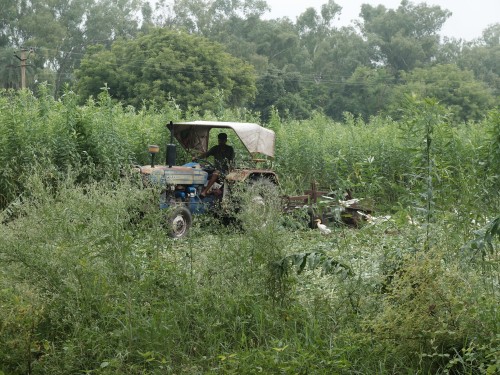
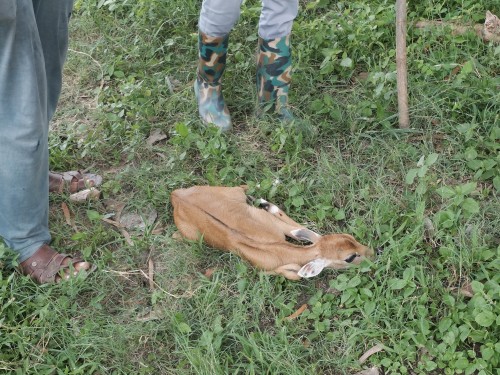
Kuldeep and an old tractor disappeared into the sunnhemp and was unaware of what wildlife was sheltering in there. He spotted what he thought was a young calf, but was actually a very young nilgai. On inspection he found the side of the plough had gone across its legs which were broken but only bleeding slightly. We bandaged its legs and I drove it to the vet. Although presumably in pain and traumatised it did not utter one sound. The vet gave pain killers and tried to stabilise its condition but it was ‘depressed’,as he said, and wouldn’t suck. The poor dear deer died in the night of cardiac arrest and the vet didn’t charge.

11th was Teja Dashmi or the 10th day of a period for honouring Tejaji, the folk hero associated with snakes. And perchance on this day a 6-foot snake was spotted outside the kitchen door and Sugna’s reaction was "Don’t kill it! Don’t kill it!"
This respect for wildlife leads to certain problems such as people are unwilling to deal with very aggressive red-faced macaques. We only had one troublesome male and it sneaked into the kitchen behind Sugna’s back and made off with a dog’s chapatti. The hallis are living with 5-10 such monkeys prowling around them while they try to cook.

A big drama in September concerned Chandani, the young second wife of our halli Dinesh. One evening, being fed up with her boorish, and probably high on alcohol, husband, she walked out taking her young stepson with her. She took no money and left her smartphone behind on which intimate short recorded messages were found with a man in Madhya Pradesh. Dinesh told the police, who identified the man and warned him off. Dinesh borrowed money and set off to bring his son back and found them both at Indore railway station not having eaten for two days. Chandni was told off by a policewoman that she musn’t disappear without telling her husband again. The police report was withdrawn and Chandni was expected to settle down, but two days later she again disappeared. She hid nearby all day in the rain and was found in the evening behind their house sheltering under a plastic sheet. She spoke to her parents and her sister who told her to stay where she was and with escape options gone she appears to have accepted her fate. She is not as young as we thought and has two or three children from her former partner, the elder of whom could be 15. The possibilities raised by smartphone technology came up against the reality of wifely commitments and no money.

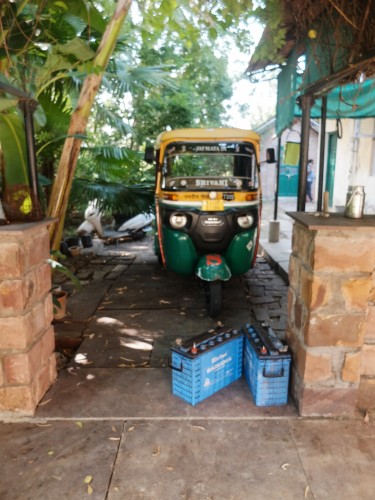
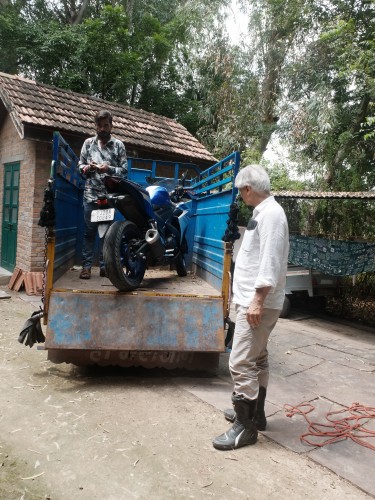
Being very humid inside the house the inverters and batteries were a god-send and when one crashed immediate action was taken. Two new batteries were ordered and were delivered by auto-rickshaw. We paid Rs. 21,000 for them after a Rs. 6,000 reduction for trading-in the old ones. Our faulty inverter is being repaired as a backup and we have been lent a service inverter.

Our cowman’s son, Deepak, had a motorbike accident while swerving to avoid a dog. Though he did not come off his foot got twisted and fractured his ankle bone. His foot was put in a plaster. But an X-ray revealed that two rods in the same leg from a previous operation, also from a motorbike accident, had bent. It seems that they needed to be taken out, but the government hospital refused to remove them as it was a risky operation which they wouldn’t ‘guarantee’. Narayan, the cowman, borrowed Rs. 30,000 to pay a private surgeon who was prepared to operate, also being the surgeon who had put the rods in. In order to get to the hospital, Deepak was carried on his bed 200 meters to the road where he could be put into a car. He has his bed under a tin shed looking out onto the cows and calves and farm life in general. The cooking is done on a mud ‘chula’ next to him. The family live upstairs but he cannot get there and holds durbars from his bed for his friends and relations. We hope the operation to remove the bent rods in his leg is a success and that he will be able to walk, work and earn again soon.

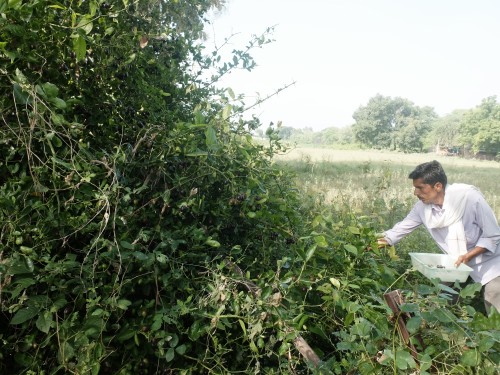
To end, here is Laxman picking karronda, which are sour and rather like sloes. They make an excellent karronda-and-apple crumble, which is a September favourite.

On the Farm - August ’24
It rained on 18 days in August for a total of 25.56 cms. which is almost half July’s rainfall. So for this monsoon we have had 78.43 cms. which has been regular but not excessive. The rice has to be kept flooded so all rain helps. The other fields are water-logged as well.


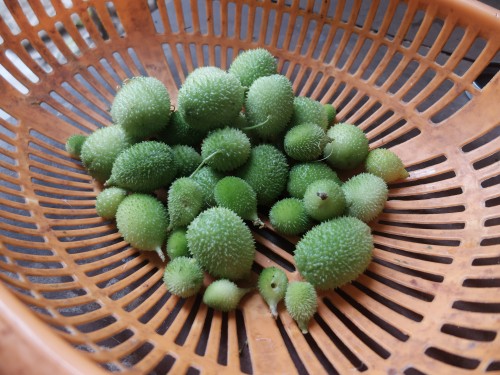
Our sunnhemp has grown particularly tall and the cows have enjoyed grazing in it. One of the wild foods at this time of the year are kakoda. They grow on a straggly creeper and are available in the vegetable market too. They are sliced and fried and are rather bitter so we don’t like them and are happy for the hallis to pick and cook for themselves.

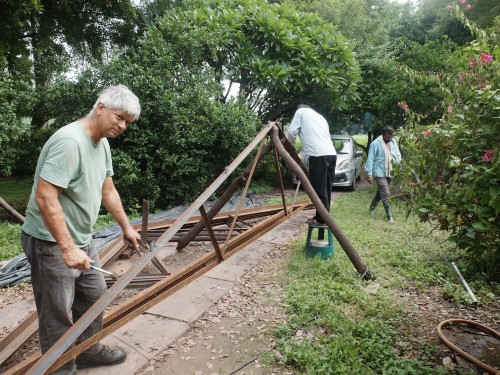
The welder came on 7th August and we prepared trusses for the new grain port. 50 tabs were welded on where the purlins will be atttached. The trusses are now wrapped in plastic sheet and waiting for the rains to finish.

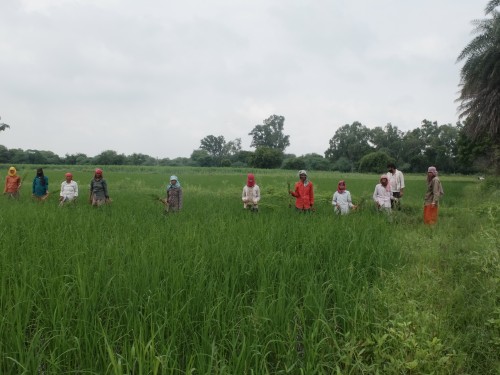
The main agricultural work involves looking after the rice and keeping it watered. A team of ten women came to hand weed it so we would not have to spray with herbicide. They keep going through the heaviest of downpours in their plastic capes. After weeding urea, zinc and bio-fertiliser were broadcast.

The high humidity means we have to be constantly on the lookout for termites or deemak appearing and chewing through pictures from the back. We also get infestation of black ants coming up through the floor and wildlife such as rats are looking for opportunities to get inside. A strange knocking sound in the air-conditioner turned out to be gecko. It detached its tail through the vent in the bottom and the next day a tail-less gecko also dropped out with the stump starting to grow back.

On 21st August there was a national strike in response to a Supreme Court order that reservation for scheduled castes (SC) and scheduled tribes (ST) should not apply to anyone earning over Rs. 15 lakhs a year or 1500 GBP - the so-called creamy layer that rises to the top and prevents the genuinely poor tribals from getting reserved jobs and positions. A lot of trouble was expected and extra police were everywhere, but the majority of the SC/ST are poor and will benefit from this change, and so it was just a token national stoppage to prove the power of the unions.

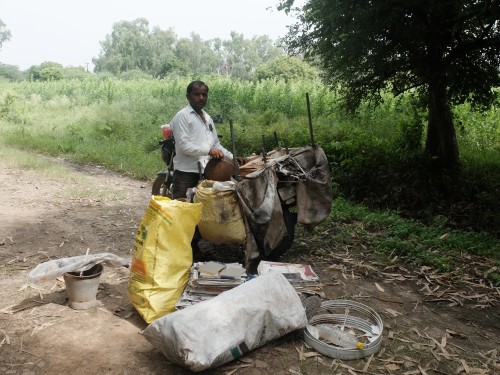
On the last day of August the kabari wallah rang up and asked to come. We earned Rs. 720 from selling newspaper,tin, scrap and plastic but he would not take any glass bottles and we have bagged them and will take them into town and dump them by a skip in the hope that someone can make use of them.

On the Farm - July ’24
This year it rained on 17 days in July giving a total of 42.63 cms. Since the temperature was still in the mid-thirties it was very humid. According to NASA’s analysis 22nd July was the hottest day on record for the planet overall. The women who were working outside transplanting rice, found the water they were standing in so warm and the sun so hot that they stopped work and went home.

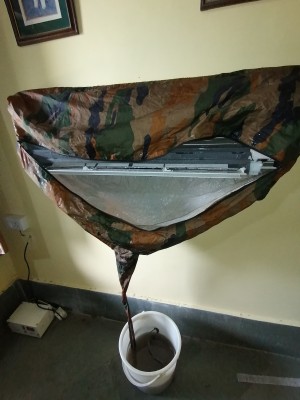
Electricity is vital to comfortable survival and at the end of June a parrot had flown into the wires by the transformer causing a massive power surge that had blown the air-conditioner circuitry, the inverter and a few bulbs. That took a few days to sort out. The AC repairmen, who had installed the Mitsubishi AC, came and discovered a fault in the main circuit board. They took it away to repair and were back a couple of days later to install it. They also serviced the split units and washed them with a pressure hose, using this ingenious rain hood inside the house.
The dogs were very happy to have the AC back and spent most of their time keeping cool in front of it. They did not go for walks because of the high humidity and Tigger built up strength.

A long standing problem was that the cable from the transformer to the house needed replacing, and because it sagged badly over the 63 meter distance, an interim pillar was needed. This was effected in July.
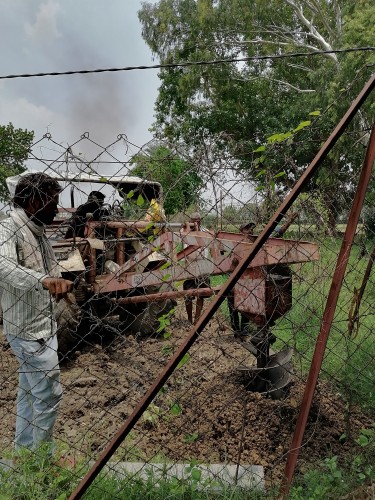
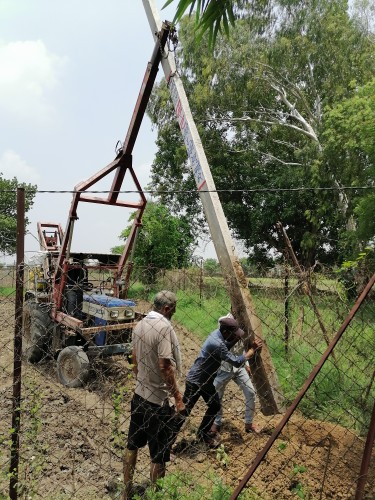

After the vegetable garden was cleared and ploughed, a tractor mounted augur drilled a hole in one corner of the vegetable plot. The electricity board team arrived with a new concrete utility pole and it was erected. A specialist pole climber had to take the armoured 4 core cable up there on his shoulder with the help of a sandal bolted to an iron frame which locked round the post and helped him haul himself up. Once the new cable, which we had had to buy in the market, had been connected up our electricity supply improved considerably.


Once the rain had started the rice fields were flooded and prepared for ‘grading’ which I call ‘guddling’ as the giant paddle wheels attached to the tractor wheels churn the mud, and then the team of women get working to transplant rice, bending over for several hours a day. They started on 13th July and kept going until the end of the month.

The sunnhemp which had been broadcast last month shot up several feet and the cows were allowed to wander at will gorging on green fodder twice a day. One cow was served by AI which used to mean artificial insemination and now has become something less tangible.

One interesting social phenomenon to end on concerns an arranged marriage between a boy in Dinesh’s extended family in Madhya Pradesh and a girl in his wife’s extended family. Dinesh took two days leave to organise the match but the girl had been diligent at school and her family refused to allow her to marry a less educated boy. A sign of the times but the boys haven’t seen it coming.

On the Farm - June ’24
June was a holiday month for the men and preparing for the monsoon. There were two fabrication projects and both were ready in time for the rains.

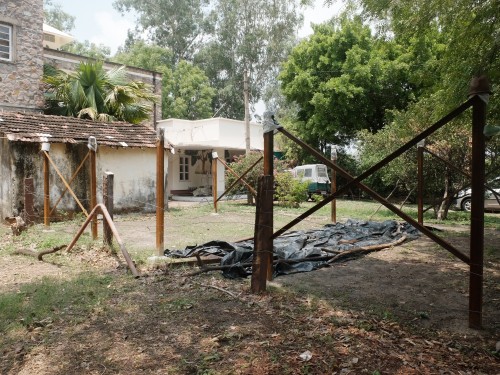
Here the corner pillars/posts are being erected for the combined car/grain port. The pillars and cross bars were cut to the required length by Vijay who did all the measuring. Giriraj, a local fabricator, came on the 26th and cross bars at both ends of the structure were welded in place. Tubs were placed over the tops of some of the pillars and plastic bags tied over the others before the first heavy rain. The basics have been done before the monsoon arrives. The first truss was fabricated on the 29th on site by Giriraj.
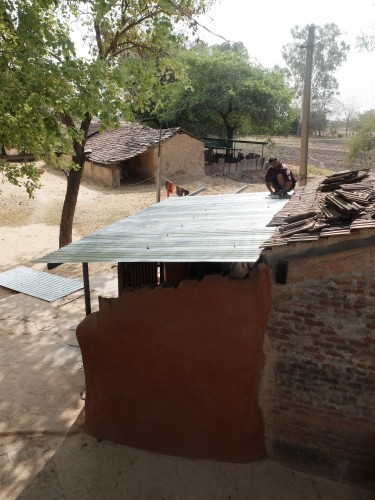
The second project was to rain proof Dinesh’s kitchen extension. His tiled roof was taken off and replaced with corrugated metal sheets on a metal frame to make the area waterproof. The rafters and purlins of the tiled roof had sagged badly over the years.

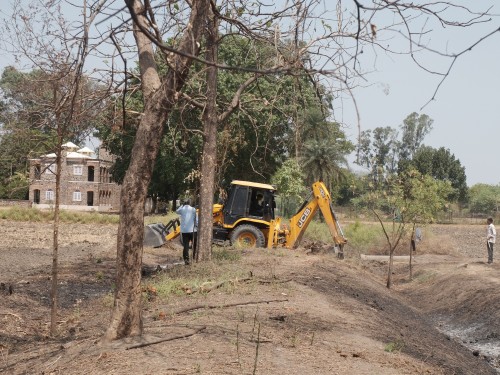
Each day the men would slash at and remove thorny scrub which is a problem when bare footed women come to plant rice. A JCB was hired to dig up the stumps of axed thorny ber trees that were proliferating the borders of the fields. You can see that the farm drain on the right has been cleared and burnt. The overall aspect of the land is dry; the monsoon will change all that.

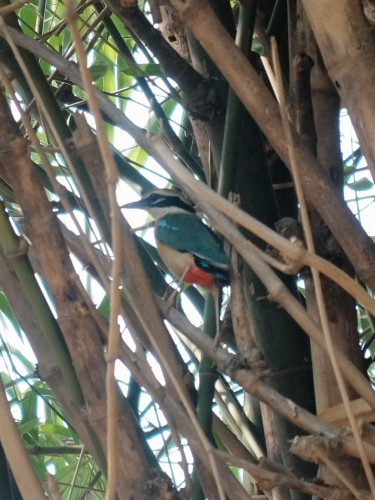
The men worked on in temperatures of over 40o C, avoiding the 12.00-3.00pm hours. We put out water for birds and animals and somehow they managed to cope. One very colourful bird flew into the front verandah in a state of exhaustion and Dinesh happened to see it. He picked it up and cooled it off in the pond by the front door and gave it some water to drink. It quickly revived, posed for photographs and flew off into the bamboo. It turned out to be an Indian pitta and is the first we have noticed on the farm.
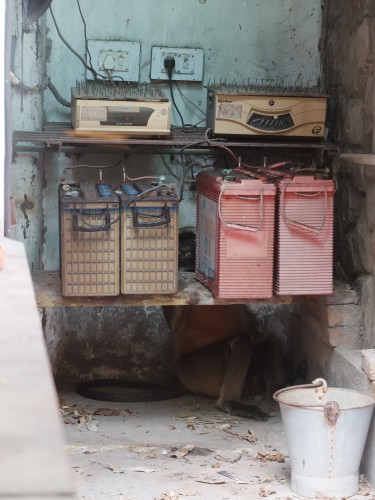
Another animal needing help was a black-faced langur with an injury to his mouth and hand. It liked to sit under the inverters and batteries next to the house and snarl at us from between them.
Tigger improved steadily throughout June. He had to be carried out supported with a towel under his tummy at the beginning of the month. By 23rd June he insisted on walking all around the farm at sunset.

All the fields were ploughed and those being left fallow over the summer were broadcast with sunnhemp (Crotalaria juncea) as green manure and then tilled/planked over. On 1st June a team of workers had filled eight trolley loads with gobar and scattered it on a field selected this year; a trolley load was dumped by the vegetable garden. These migrant workers are known as Mammas and are tribals from Madhya Pradesh who camp near here looking for such labouring work. They were paid Rs. 425 to load and unload one trolley.
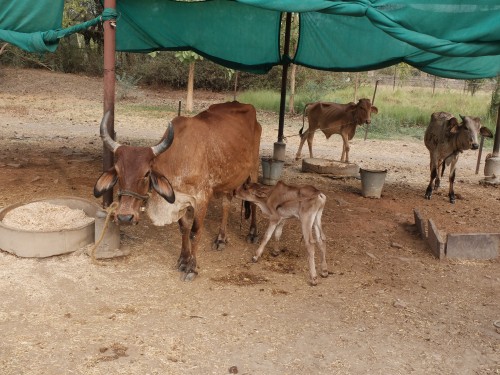
One addition was born to the cows producing the gobar. Meera (daughter of our beloved Mun-Mun, who died aged 21 some years back) gave birth to a male calf on 16th June at 4.30am. She did not expel her afterbirth, which is a potential emergency, and we called a retired vet willing to heed our call. All was well and the calf was named Arjun. But mysteriously an 18 month old male calf was found dead in the cowshed on the 24th. He had not been malnourished but that is the usual reason that the young males die. Summer before the new monsoon grass grows is the most challenging time for them.

June 2024 was the month in which the national election results were declared and it was curiously quiet on 4th June - the expected celebratory fireworks were not heard. Congress had done better than expected contrary to the exit polls predictions, and the Bharatiya Janta Party (BJP) did not get an absolute majority and had to rely on coalition partners to return to govern, giving the overconfident a jolt. There is now an opposition in the Lok Sabha to speak of and the all powerful youth voters are demanding jobs rather than money spent on beautification and such like. Kota’s M.P. Om Birla had to survive the first contested election for the Speaker’s post since 1952, but it was close. A stable and experienced team has been inducted at the top with some new faces on the fringes but consensus will take longer from now on and no one can be taken for granted. For the record BJP is by far the biggest bloc in the Lok Sabha, 2.4 times bigger than the Congress. The opposition is an unstable collection of disparate parties.

On the Farm - May ’24
May was unusually hot this year with only one short storm on 18th May to bring the temperature down from the forties. We are at least 3o - 4o C cooler than town and our thermometer recorded 39o C on the 22nd under a shady pergola.
My Honda Brio’s AC could not cope and would blow hot air after 12:00 mid-day. That was dealt with by having a new compressor fitted as I was persuaded that 100,000 kms. was the limit for the original one. People who used to be very careful about security now leave their AC on while they go into a shop to be able to get into a cool car on their return.

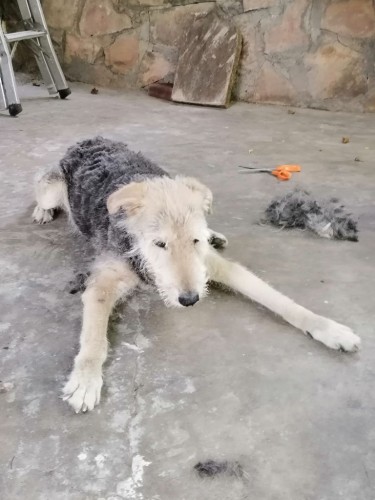
Tigger, now aged 14, could also not cope with the heat and collapsed after a walk. He was clipped of his excess hair, demisted regularly, kept in front of an AC, fed by syringe with liquidised liver and gradually recovered his strength.

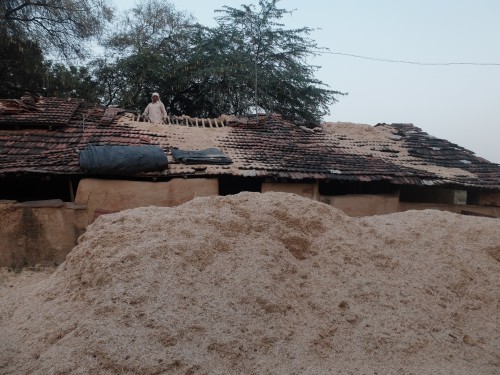
Farm activities continued despite the heat. The wheat bhoussa which had been dumped in front of the cowshed had to be filled into the rooms through the roof by removing the tiles first. Then the tiles were laid back again.

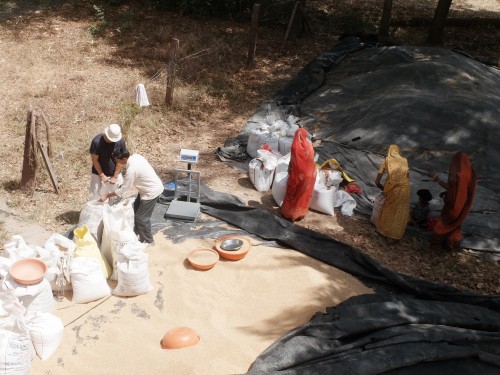
The wheat was bagged for the women cutters and taken home on their husband’s motorbikes. The yield was low this year which might have been due to the early heat in the spring.

Mewalal, our former cow man, who comes every morning to greet us was weeping one morning as his state pension had not been paid for two months. The authorities do this deliberately so people turn up and verify themselves. I wrote a letter for him to take to the Nagar Nigam (city council) help desk and they rang me from there to say he had turned up and was verified. He then wanted to arrange medical care for his daughter with Downe’s syndrome, who was said to have a painful lump in her midriff. He was entitled to a free scan but the queues are so long that after paying for his three-wheeler transport and arranging a literate helper three days running, it was cheaper to pay for a private scan. Luckily, her problem was not serious.

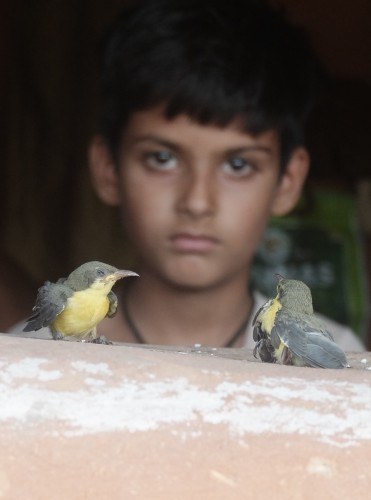
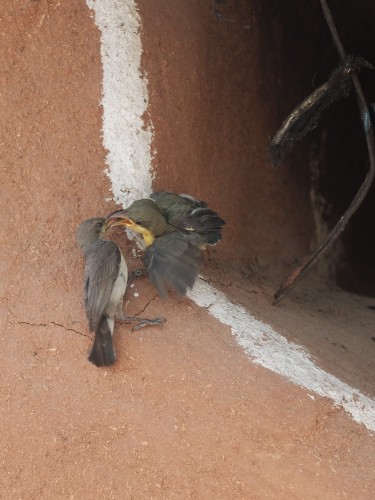
Gautam spotted these tiny yellow breasted chicks of purple sunbirds (Nectarinia asiatica) on the ground in front of his dwelling on the farm and brought them into their cooking verandah to give them shade and water. He would place them on the wall and within seconds the anxious mother would swoop down from a nearby tree and feed them. The chicks learnt to fly and disappeared the next day. The nest in which they had hatched was a small untidy pendulous pouch of leaves, grasses, etc. suspended about 8 feet above the ground from the tip of branch of a sheesham tree outside Gautam’s house and he had been following their lifecycle closely.
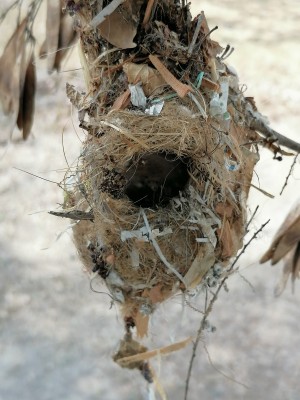 Orinthologist Dr. Salim Ali describes it thus: 'Nest - an oblong pouch of soft grasses, rubbish and cobwebs, draped with pieces of bark, woody refuse and caterpillars’ droppings, with projecting portico above the lateral entrance hole. Suspended from the tip of a branch of bush or creeper at moderate heights, often adjacent to an occupied bungalow.'
Orinthologist Dr. Salim Ali describes it thus: 'Nest - an oblong pouch of soft grasses, rubbish and cobwebs, draped with pieces of bark, woody refuse and caterpillars’ droppings, with projecting portico above the lateral entrance hole. Suspended from the tip of a branch of bush or creeper at moderate heights, often adjacent to an occupied bungalow.'

On the Farm - April ’24
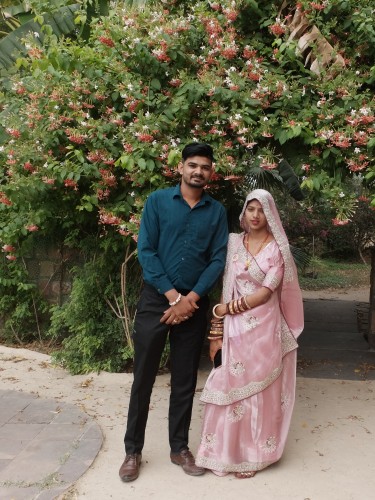
April is our main wheat harvesting month. It is also a popular month for weddings and the elder son of one of our farmhands got married so his father took 10 days off and borrowed lots of money. All went well and Vijay, who is named after my husband (!), brought his wife Kareena to meet us. Vijay works making furniture in Kaithoon the next big township. Kareena has just joined the household and will probably do the domestic work while her mother-in-law is at work.


Mother-in-law used to be part of this gang of women who hand cut our crops but she now has a domestic job. These women would arrive by 7:00am and leave at 6:30pm. They cut 20 bighas of commercial wheat and tied it into bundles. When these were dry they piled them up from 3:00am to avoid the heat ready for threshing.
We also had some heritage wheat of two varieties, C306 and Bansi which we are trialling. Our men cut that and tied it into bundles.

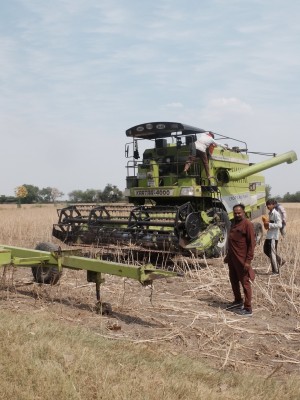
On 12th April the combine arrived and is seen here being put together. It has Crop Cruiser and Hurricane Harvester written on the side. Between 2:30pm and sunset at 7:00pm it had cut and threshed another 30 bighas of commercial wheat leaving the staw strewn around the fields.

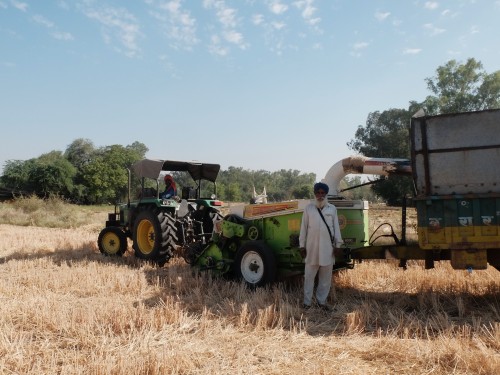
A few days later the hay making machine arrived owned by the Sikh in the photo. It went around the fields very slowly cutting the stubble, picking up straw and chopping it up and blowing it into the trailer which was then exchanged for an empty one while another tractor took the full one to our milkman who was paying the costs. We got Rs. 5000 only for the lot but our excess straw was taken off as fodder and we did not have to burn it which is illegal but still common.


On 20th the women piled up from 3:00am and threshed from 7:00pm until 3:00am on the 21st. They finished on 23rd night. There was a full moon and heavy fragrance of the madhumalti or honeysuckle seen in the first photo above the newly married couple. The gulmohar tree in the background with its bright red flowers was in full bloom. We managed to get through the entire harvest period with no rain.
However, 26th April was dramatic as it started with a massive clap of thunder at 5:00am and one millimeter rain which helped to bring the temperature down from the high thirties and maybe encouraged more people to turn up to vote in the General Election as the average queueing time was 2 hours. I went at 6:50am and was 6th in the ladies queue. From 7:00am they let 2 women in and then 2 men. Indside the voting room there was only one electronic voting machine with a matching paper trail in a separate machine. The results will be announced on 4th June.

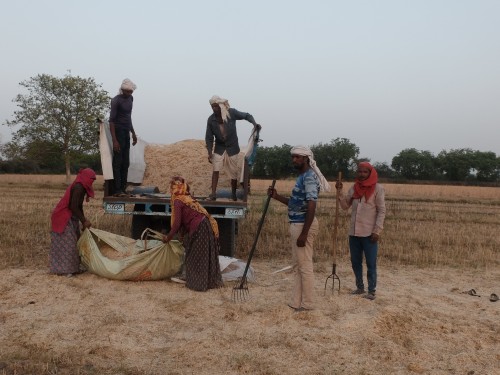
The last job after harvest is to bring the bhoussa in for storage. This is the chaff that is left in piles after the thresher has threshed the hand cut wheat and it is eaten by our cows. We employed a family from Jhabua district in Madhya Pradesh who move up to Hadoti during harvest to make money labouring. A group of four men and two women of Bhil Thakurs started work at 8:00pm on 29th April in a very hot wind. They worked all night and all the next day until 8:00pm by which time they had earned Rs. 12000 as each trolley load was Rs. 500 and each trolley load subsequently put into the bhoussa ghar through the roof cost another Rs. 500.


And to end with here is a photograph of a young spotted owlet found on the verandah. It was put back in the garage until it is strong enough to fly. They live amongst the tiles and beam of the garage roof.

On the Farm - March ’24
March’s blog will end with a culinary flavour as we experimented with a fire pit. More later.
There were 2 millimeters of rain on 3rd March which refreshed the greenery but didn’t damage the mustard being harvested. Temperatures have been higher than usual so we cleaned the air conditioner and the desert cooler and changed the cooler pad. A squirrel’s nest was removed from the split AC external unit but we know from experience not to start the AC before checking for wildlife in residence.


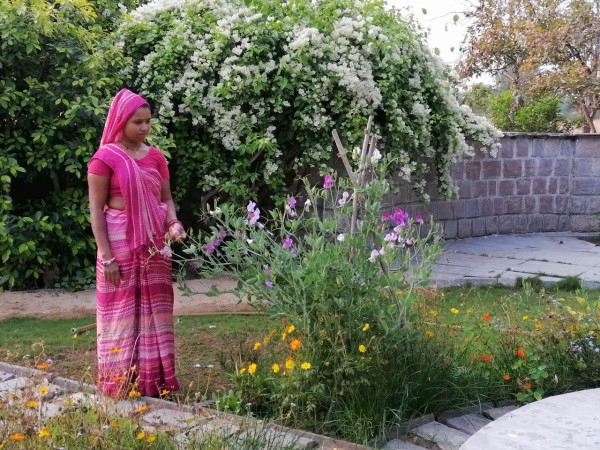
The green fodder for the cows grew well and was supplemented with cotton cake and chickpea chaff. Considerable effort is required by two men each morning to cut the fodder. The peacocks seem to enjoy sharing it and nilgai have to be chased away. March is spring in North India and my sweet peas gave great pleasure until it got too hot for them. They are seen here with Chandini who was employed to weed the lawn. Delhi airport is a riot of colour in March with acres of bedding plants on the approach roads.


By 8th March the mustard was ready to be threshed. Eight women had been cutting since 17th February. They are paid Rs. 1450 per bigha of area to cut, pile and thresh. We had 30 bighas under mustard, and it will be sold in April. The yield looks not too good and the market prices are down, and certainly not as high as in 2021-2022 when there was a national panic over seed oil, and palm oil was not allowed to be imported.

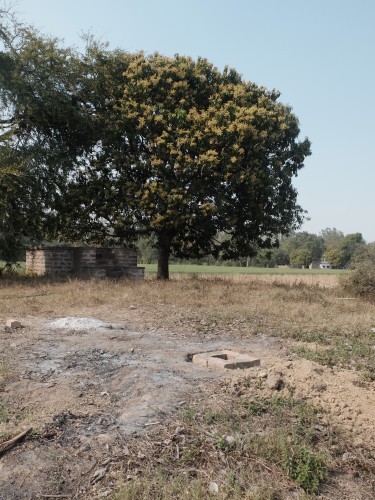

And now for our culinary adventure inspired by a Japanese countryside cooking video. Here is a brick-lined fire pit prepared on the farm to Vijay’s specification. In our recipe no seed oil or water is used, only pure ghee. You can see the flowering mango tree in the background marking the spot where my mother-in-law was cremated.
Vijay went to a haat or market 23 kms. away to Choma village (which has the very old Charchouma Shiv Mandir) to buy a rounded terracotta cooking pot, black in colour, known as a handi. Pieces of tender goat meat, curd, ghee, green coriander, green chillies, onions, cumin seed, ginger, garlic and salt were thrown into the pot and the lid sealed with wheat dough. The fire was lit in the pit with twigs and small sticks and the pot placed in a hot pit with the lid weighted down. After cooking for an hour-and-a-half, the dish was enjoyed at a family lunch. Delicious.

On the Farm - February ’24
February was a lovely month. We had less than 1 mm rain and day time temperatures were in the early 20’s. Nilgai and pigs coming every night had to be chased off and the wheat was being watered from the tube wells.

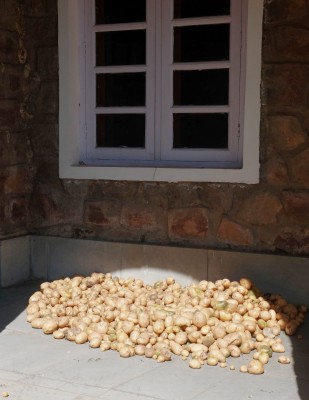
At the beginning of February the potatoes were dug up and you can see them here drying on the verandah. We gave a few kgs. to each employee and stored the rest.
While buying sacks of fodder for the cows it was discovered that the brakes of the Gypsy did not work at all and the hand brake had to be employed to control the four-wheeler! We called the mechanic who found that the brake fluid had totally vanished, so he topped up the brake fluid and drove carefully back to his workshop in town only to find that by the time he got there the brakes had failed again. We insisted they change the entire braking system and they changed the brake cylinders in the front wheels rather than try to repair them (the old cylinders had seized completely). One wonders what the state of the brakes are on some of the older vehicles on the road with no annual MOT. Delhi bans any vehicle over 10 years old in an attempt to cut air pollution and so those older vehicles get sold in smaller towns often under the previous owner’s name as it’s hard to re-register them in another state. Newer cleaner cars pack the roads but the older ones don’t get scrapped. The car industry is shown to be booming but where is it all leading?

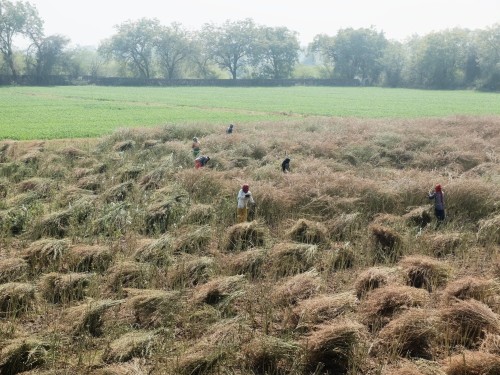
The women arrived on 17th February and started cutting the mustard. By 23rd they had reached the centre of the largest field and it smelt. The women discovered the remains of three pigs that had retreated into the thick mustard to die. We called a sweeper and he lifted two of them on a plastic sheet and tied the third and dragged it - all to be heaved over the boundary wall to a gully with dense thicket. Hopefully the local jackals which roam our wilds finished the job.

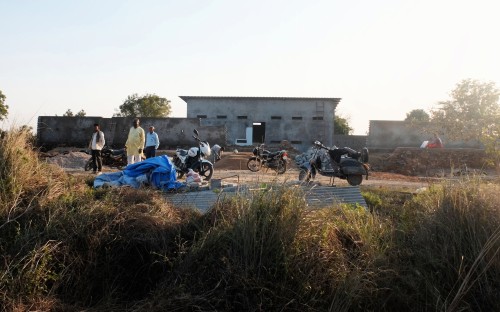
We employed a lot of people in February one way or another. Work went on on the gas warehouse at the end of the farm and by the end of the month the roof was on and most of the boundary walls built.
On the same day as the pigs incident the house motor/pump burnt out in our open well. We called Ashok on 23rd and he came on the 24th and hauled it up. He took it away to rewind and returned on the 25th at 8:30am and refitted it. Later that day smoke was spotted coming out of a meter on the outside of the transformer. We called the linesman and he sent an electrician who braved the small bees which had taken up residence in the transfomer and removed a squirrel nest and parts of its owners which had also been using the meter box since the glass over the meter was broken. An earthing wire was found to be detached and finally by 14:00 the electrician left with a tip equivalent of 5 GBP.
On the 26th it became apparent that the squirrel incident had caused the fridge cooling system to burn out. You can’t just ring al LG service engineer any more and we worked out how to ‘register a complaint’ on their Whatsapp national system. On the 27th two uniformed engineers appeared on a motorbike, identified the problem and ordered the parts. On 28th they came back and fitted them with nominal charges for parts and two call outs. Well done LG!


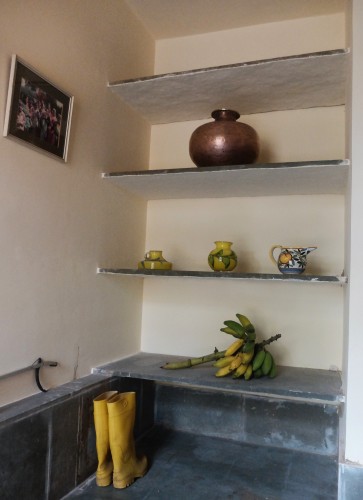
February had an extra day and on 29th the weight of a bunch of bananas brought down a banana tree so we harvested the bananas, shared most of them out and put the rest to ripen in our display area inside the front door. We can’t use it as a cupboard any more as termites can appear through the walls at any point. We don’t want to use toxic chemicals and must learn to live with the problem by not leaving cellulose in termite infected areas.

And so February began with potatoes and ended with bananas.

On the Farm - January ’24
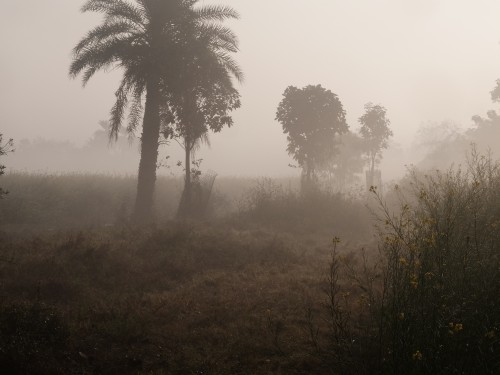
This January was memorable as the sun did not come through for the first six days and the first normal sunny day was 12th. There was 6mm of rain on 9th January which cleared the air but the men felt too cold to work and huddled around fires in the mornings. Max temperatures were 12oC/13oC.

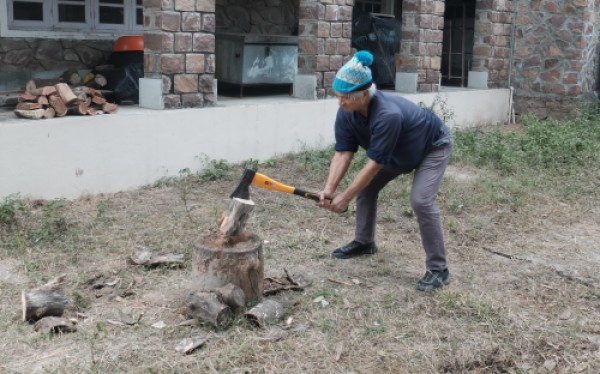
We had log fires in the house using our own wood. Here is an action shot of Vijay splitting logs having cut them with his chainsaw.


It was good cool weather for picking up litter which I do from time to time. Our newly surfaced road encourages townies to come out and feed the monkeys which line up on the wall in the morning waiting. The good hearted souls scatter bananas, peas, biscuits etc. and then throw the wrappers and plastic bags in the ditch thoughtlessly.

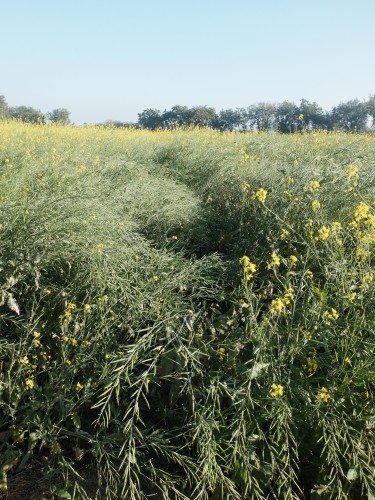
The brilliance of the flowering mustard gradually faded but the plants grew and spread protecting the wild life sheltering in it. You can see pig trails where the wild boar made their own motorways.

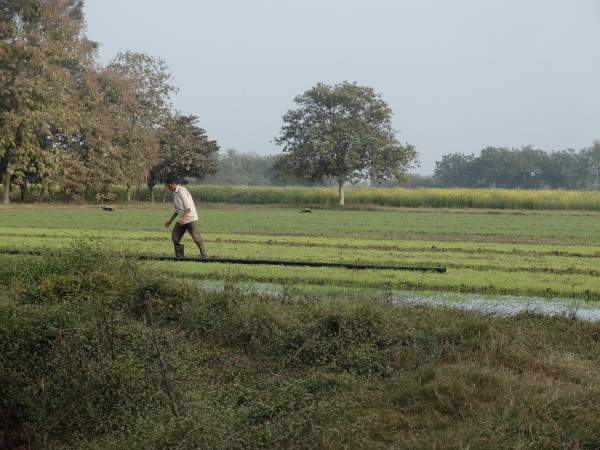
The bersim/alfalfa for the cows grew well and here can be seen being watered by Laxman. It was fed to the milking cows and the calves as they could not go out to graze. The heritage wheat is beyond it where the peacocks are pecking.

Tigger, who had been regaining strength through December thanks to daily ration of goat liver each morning and chicken in the evening, barked on 9th January for the first time since November. His back legs, although arthritic, are much stronger and he looked forward eagerly to his daily walk in the evenings.

22nd January, 2024 was a day to remember and will be an annual holiday to remember the consecration of Ayodhya Temple and the return of Ram to Ayodhya after two thousand years of exile. Hindus around the world were celebrating and we gave laddus to the workers to participate in the general jollity.
On the Farm Archives
Some Farm Activities
Relax/read in sunshine
Bird watching
Walk the dogs
Watch cows being milked
Learn about local customs
